2. Mud Flats (Zone 1)
A. Mud Flats: General Information:
As the tide recedes to its lowest point, vast areas of mud are exposed. Large numbers of species, invisible to the naked eye, live here. A few macroscopic organisms also call this home. Mud consists of inorganic particles such as sand grains mixed with organic particles mostly derived from the decaying remains of marsh plants.
Our journey begins on the relatively bare sediment surface at low tide. Water is always moving over the bottom either because of the wind, incoming or outgoing tides or seaward flowing rainwater or a combination of these factors. Often water movement stirs up the bottom making water turbid thereby reducing light penetration. Sediments in certain locations are soft, making it difficult for organisms to gain a foothold. These are only a few of many obstacles faced by organisms living here.
A typical mud flat is shown above. Depressions in the mud in the first photograph were created by clam and worm diggers. The mud flat extends upward into the marsh proper through a series of channels shown in the next photograph. Water runoff from land drains through these channels (creeks) into the ocean. Just beneath the mud surface there is little oxygen due to bacterial breakdown of organic matter.
________________________________________________
B. Plants and Animals
Organisms discussed below are found in or on the mud in meandering tidal creeks or along more seaward mud flats associated with marshes. I have omitted several invertebrate groups as well as most of the vertebrates. Descriptions are included for the most abundant organisms. Most of the animals are present throughout the year, although many migrate to deeper water during winter months.
Connections to selected websites are listed beneath the scientific name of each species. Wikipedia (http://en.wikipedia.org/wiki/Home_Page) , a free encyclopedia, generally provides more specific information about the species in question. Keep in mind that anyone can edit information on this site. The Plants Database published by the U.S. Department of Agriculture (http://plants.usda.gov/java) makes available a wealth of information on most plant species as well as “related websites” and additional “species accounts and images” in the “more accounts and images” section at the bottom of the page.
___________________________________________________________________________________________________
Animals
1. Phylum Porifera
Halichondria panicea (Bread-Crumb Sponge)
http://en.wikipedia.org/wiki/Halichondria_panicea/
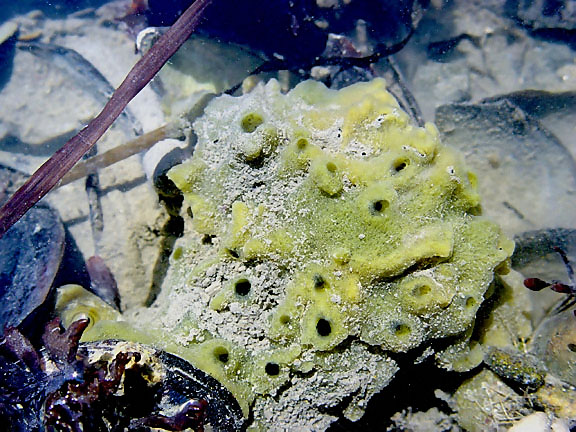
The Bread Crumb Sponge is a filter feeder. It draws water in through small openings (Ostia), visible in the photograph. Water exits through the larger openings (Oscula) and small organisms such as bacteria and protozoa are removed internally by flagellated cells called choanocytes. The flagella are responsible for creating the water current.
__________________________________________________________________________________________________
2. Phylum Cnidaria
a. Obelia spp. (Class Hydrozoa)
http://en.wikipedia.org/wiki/hydrozoa/
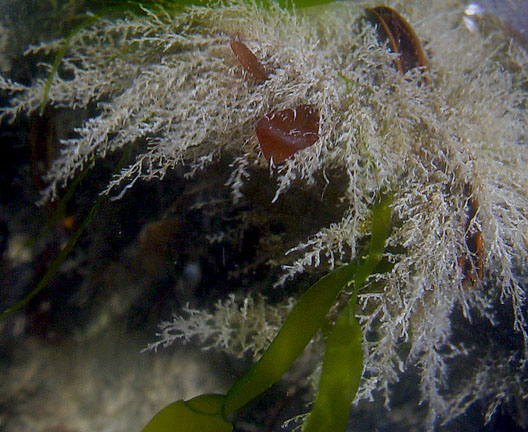
b. Metridium senile (Brown Sea Anemone)(Class Anthozoa)
http://en.wikipedia.org/wiki/Metridium_senile
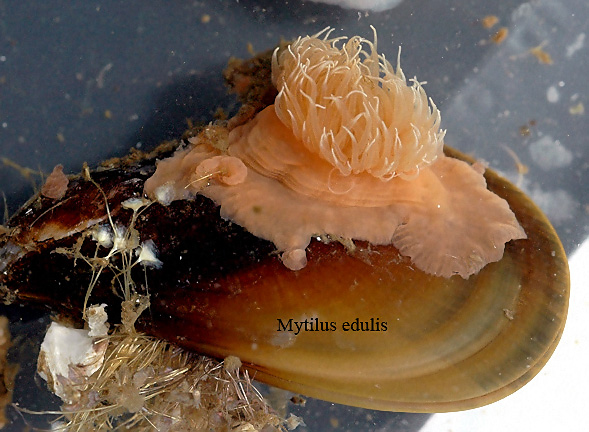
___________________________________________________________________________________________________
3. Phylum Nemertea
Cerebratulus lacteus (Ribbon Worm
http://en.wikipedia.org/wiki/Nemertea
___________________________________________________________________________________________________
4. Phylum Annelida (Class Polychaeta)
a. Nereis succinea (The Common Clam worm)
http://en.wikipedia.org/wiki/Nereis_virens
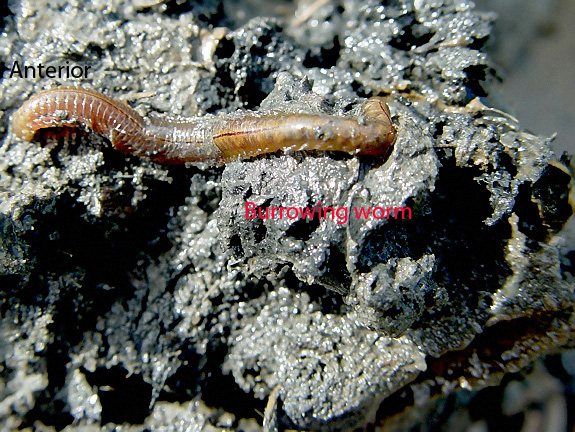
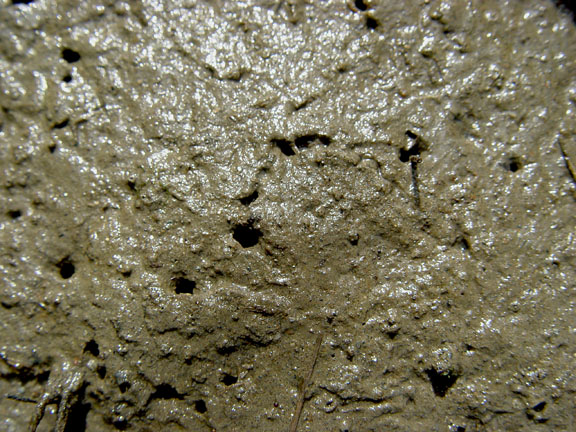
Small holes are often visible on the sediment surface in marsh tidal creeks. They most likely are the openings of burrows occupied by the segmented polychaete worm Nereis succinea. This species, about 7 cm long, lives in a series of interconnecting, mucus lined tubes that meander through the sediment. Worms feed on small invertebrates by everting their proboscis, grabbing the prey with two jaws and then rolling the proboscis inside the foregut with the prey attached. They can also filter feed on small organisms suspended in the water column. They secrete a net from special glands in the parapodia and then they undulate their body drawing water through the net. When the net is full, they consume it. The worm can also absorb organic compounds such as amino acids directly through the skin. The antennae, palps and cirri (Refer to the photographs of Nereis virens, below), help them detect prey and monitor their environment.
Adaptations:
1. Lives in a tube that protects them from predators.
2. Feeds for the most part when covered by seawater making it more difficult for predators such as birds to detect them.
3. Has the ability to regenerate missing body parts.
b. Glycera americana (Blood Worm)
http://en.wikipedia.org/wiki/Glycera_americana
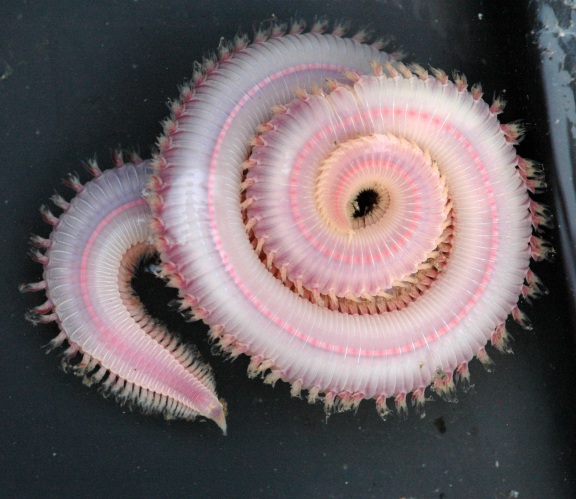
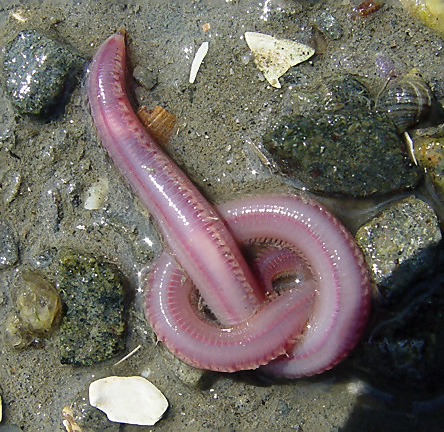
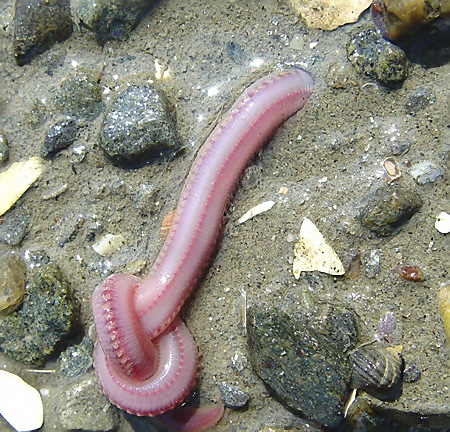
c. Nereis virens (Clam Worm)
http://en.wikipedia.org/wiki/Nereis_virens
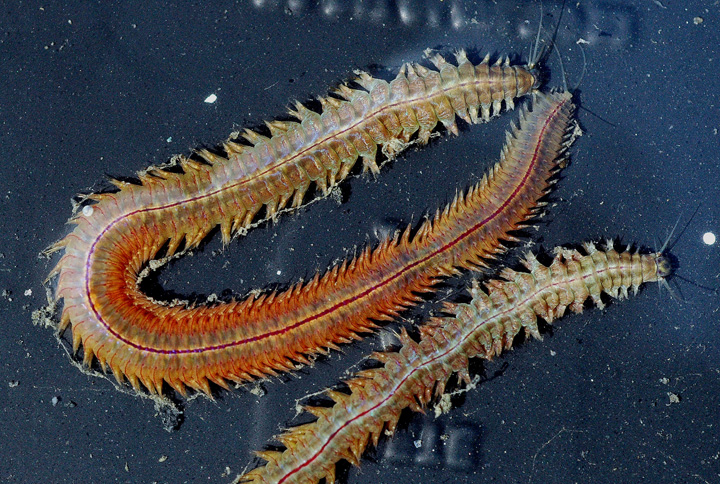
Note the vertical clam worm burrow extending from the surface down into the sediment. The fourth photograph shows Nereis burrowing into the sediment.
_________________________________________________________________________________________________
5. Phylum Mollusca (Snails and Bivalves)
Snails (Gastropoda)
a. Crepidula fornicata (Common Slipper Shell)
http://en.wikipedia.org/wiki/Crepidula_fornicata
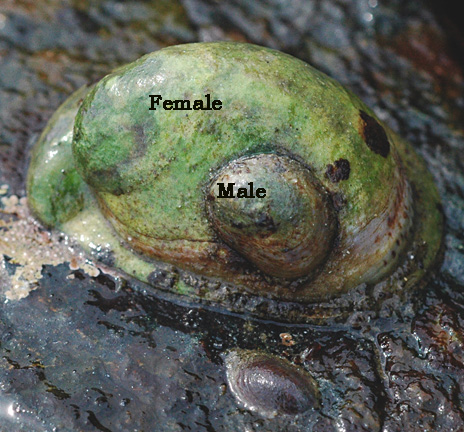
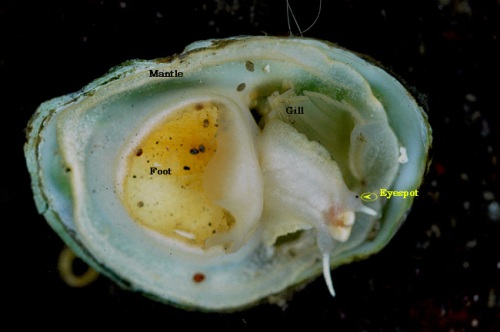
The shell, about 25mm long, is somewhat oval with an inner shelf that the foot lies against. The visceral mass is situated dorsally, above the shelf. When the animal is removed and the shell is viewed ventrally, it looks like a boat; some call it the boat shell. This species is a filter feeder. Cilia on the gill filaments draw water under the shell and over the gills. Mucus on the gills traps food particles and the mixture of food and mucus is rolled by the cilia into a string that is finally drawn into the mouth by the radula. Snails tend to pile on top of one another. The larger snail at the bottom of the stack becomes the functional female and the smaller snail at the top becomes the functional male. Is the ability to change sex an advantage to the mollusc? This species lives in areas just below the marsh proper.
Adaptations:
1. Has a hard shell that protects soft body parts.
2. Can clamp themselves down on a hard surface using their foot (suction) making it difficult for predators to dislodge them.
3. Can filter feed on particulate matter from the surrounding seawater.
4. Can change sexes depending on their position in a stack of individuals. This generally ensures that at least one male and one female are available to reproduce.
b. Ilyanassa (Nassarius) obsoleta (Mud Snail)
http://en.wikipedia.org/wiki/Nassarius_obsoletus
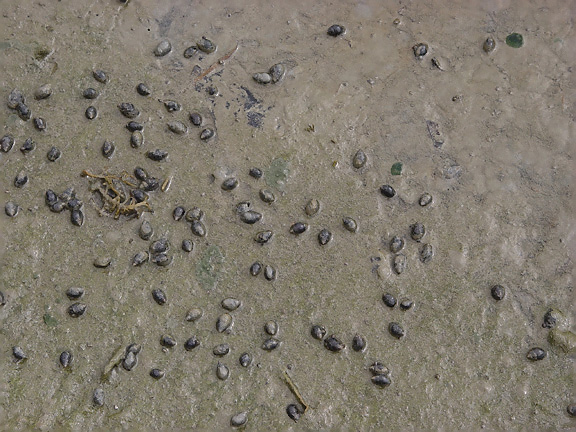
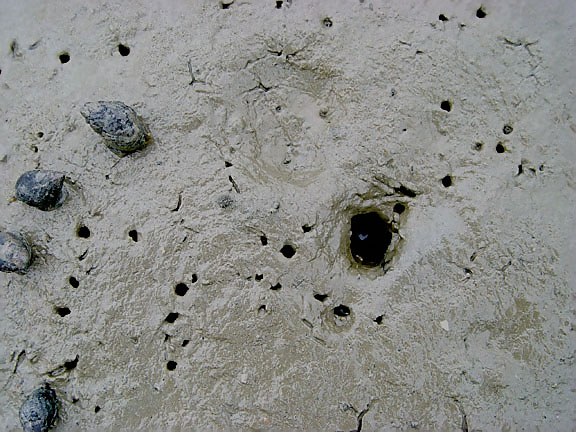
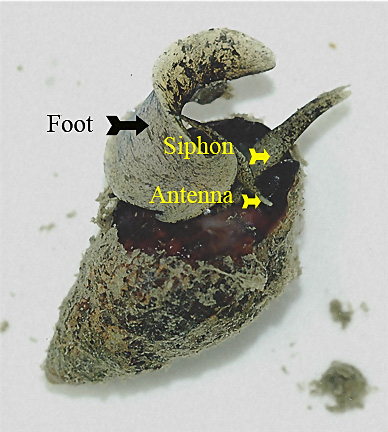
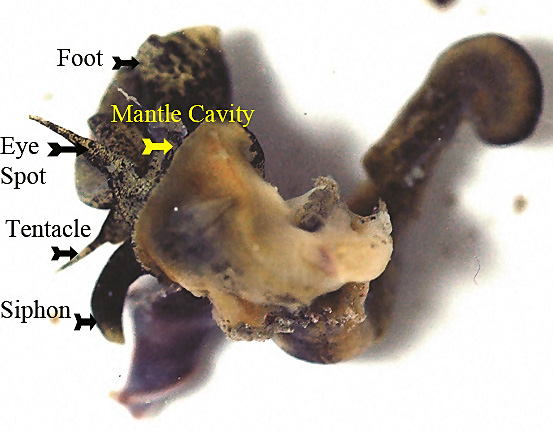
The mud snail, about 1.5 cm long, grazes on the mud surface using its radula to consume organic matter including bacteria, microscopic algae and small invertebrates. Water taken into the siphon passes over a chemosensory organ called the osphradium. This allows the snail to locate food such as large dead or dying organisms. They triangulate in on prey by moving their head back and forth and then home in on the scent. This species harbors the intermediate stages of several trematode (Flatworm) parasites.
Adaptations:
1. Can detect prey with a chemo-sensitive organ called the osphradium.
2. Has a large flat foot that allows them to glide over rough surfaces. Mucus, secreted by the anterior part of the foot, reduces friction on the bottom of the foot as the snail moves forward.
c. Littorina littorea (Periwinkle)
http://en.wikipedia.org/wiki/Littorina_littorea
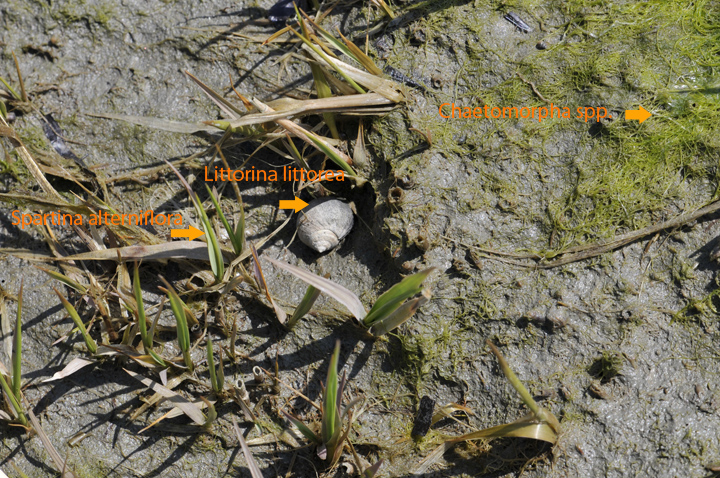
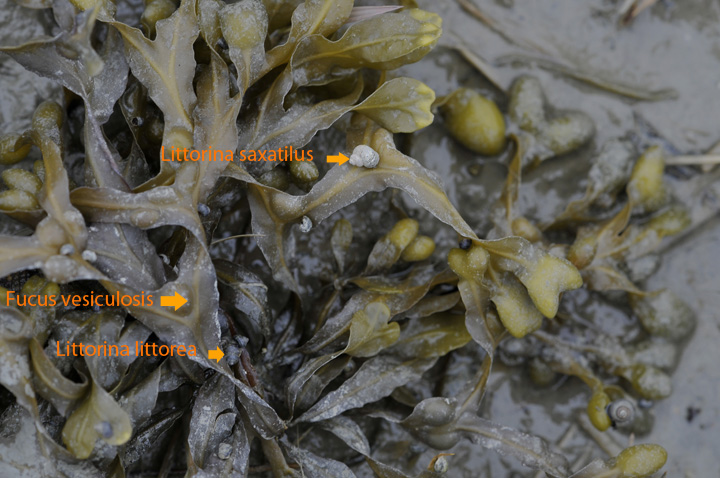
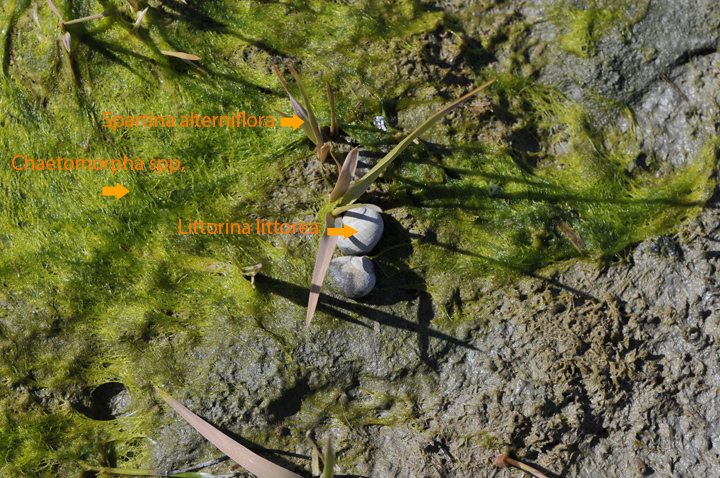
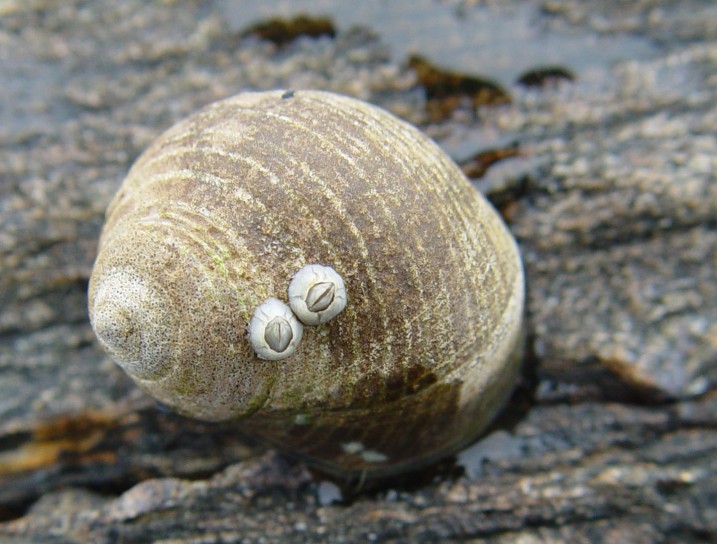
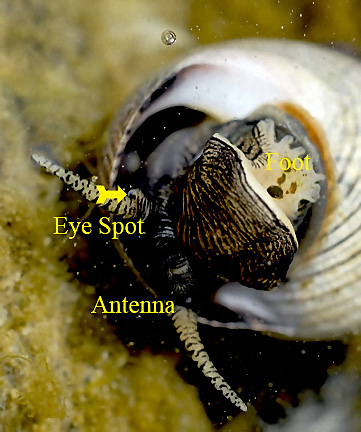
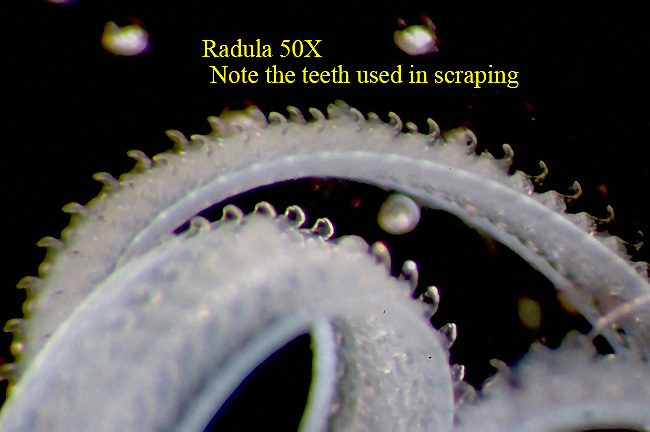
The periwinkle Littorina littorea, about 1.5 cm long, feeds on algae by scraping mud or solid surfaces with its radula . Reactions to light, gravity and wave action help the animal maintain its position in the intertidal and cover a maximal feeding area. The periwinkle is covered with a heavy calcareous shell that protects it from mechanical injury and desiccation. In addition, under adverse conditions it seals the shell opening with a cover (operculum) thus protecting the soft internal parts from contact with the environment. The periwinkle has separate sexes and internal fertilization. Fertilized eggs are released into the plankton and after a suitable period of development, leave the plankton and settle on the bottom. This species is harvested for human consumption in certain locations. The periwinkle can also be found in the Spartina alterniflora zone.
Adaptations: Same as above.
f. Melampus bidentatus
http://en.wikipedia.org/wiki/Melampus_bidentatus
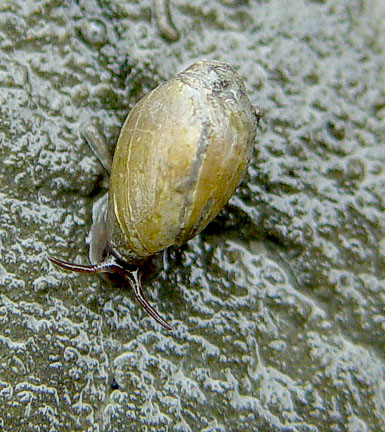
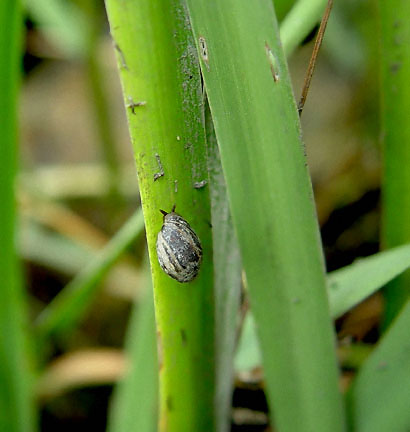
The pulmonate snail Melampus bidentatus, about 12 mm long, feeds by scraping material from mud and/or marsh plant surfaces with its radula. Food items might include pieces of leaf, bacteria and microscopic invertebrates. It is common on the mud surface in tidal creeks and on Spartina blades. This species is extremely tolerant of dehydration and can quickly re-hydrate when water is available.
Adaptations:
1. Has a rasping radula that efficiently scrapes films of micro-organisms from semi solid and solid surfaces.
2. Has a shell that protects soft body parts.
3. Has a large flat foot that allows it to glide over rough surfaces. Mucus, secreted by the anterior part of the foot, reduces friction on the bottom of the foot as the snail moves forward.
g. Nucella lapillus (Dogwhelk)
http://en.wikipedia.org/wiki/Nucella_lapillus
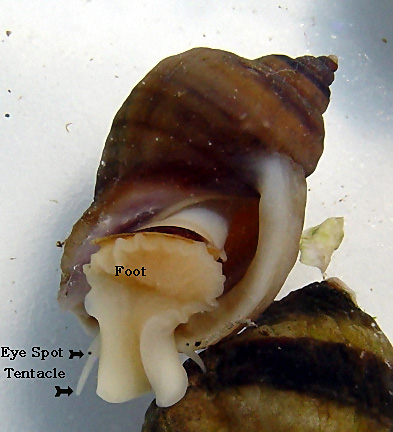
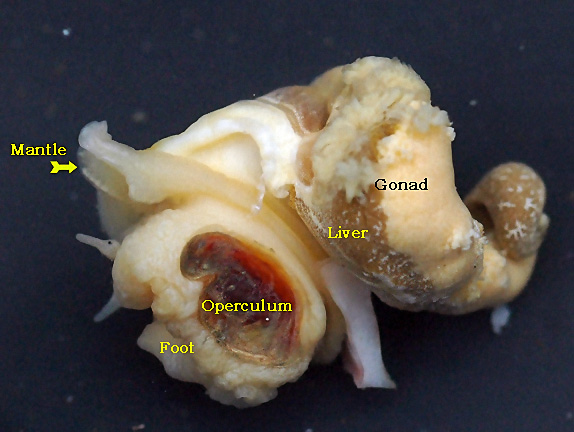
The dogwhelk, Nucella lapillus, is a carnivorous snail, about 2 cm long, that lives in northern temperate waters both in the United States and Europe. It feeds almost exclusively on barnacles and blue mussels by chemically and mechanically drilling a hole through the shell and then consuming the flesh beneath. This species lives in areas where barnacles and blue mussels thrive.
Adaptations:
1. Same as above.
2. Possesses a unique feeding mechanism that allows them to “drill” into prey such as bivalve molluscs, univalve molluscs, and barnacles.
h. Buccinum undatum (Common Whelk or Waved Whelk)
http://en.wikipedia.org/wiki/Buccinum_undatum
i. Urosalpinx cinerea, Atlantic Oyster Drill
http://en.wikipedia.org/wiki/Urosalpinx_cinerea
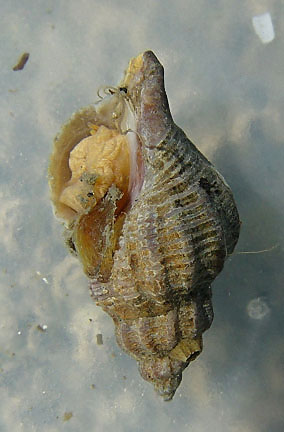
j. Onchidoris spp. (Nudibranch)
http://en.wikipedia.org/wiki/Onchidoris
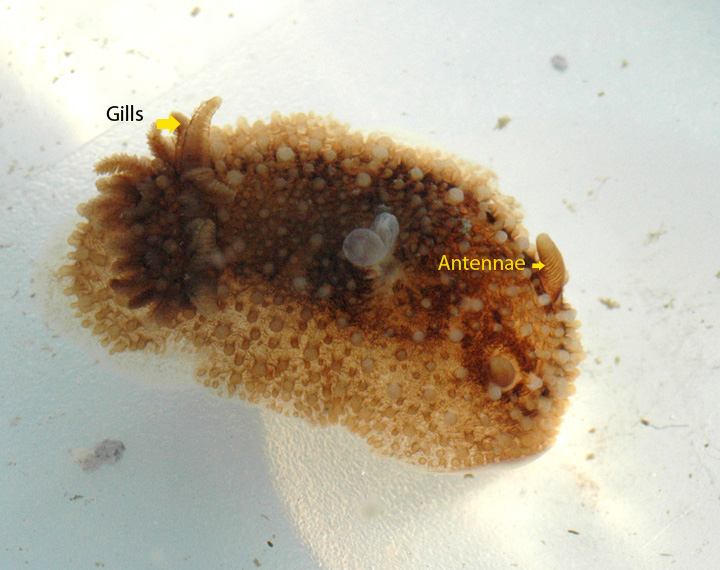
The nudibranch Onchidoris spp. , about 2 cm long, is in the process of laying eggs on a blue mussel. It was collected in an eelgrass bed where a small marsh drains into a bay. This species feeds for the most part on barnacles and hydrozoan coelenterates.
Adaptations:
1. A broad, flat foot that glides over rough surfaces.
2. Passes nematocysts (stinging cells) from digested prey (Hydrozoan Coelenterates) to the bumps (Cerata) on their epidermis . The nematocysts help protect the animal from predators.
___________________________________________________________________________________________________
Bivalves (Class Bivalvia)
k. Mya arenaria (Soft-Shell Clam)
http://en.wikipedia.com/wiki/Mya_arenaria
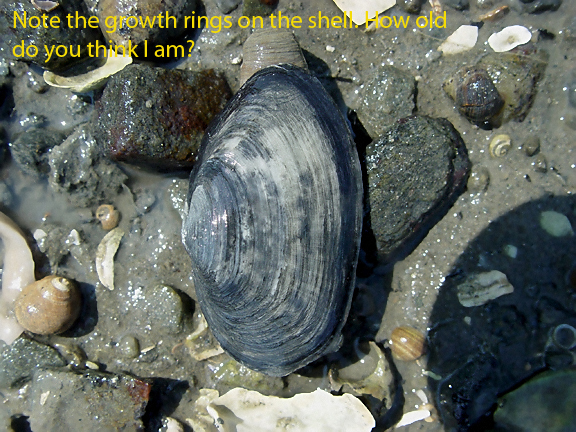

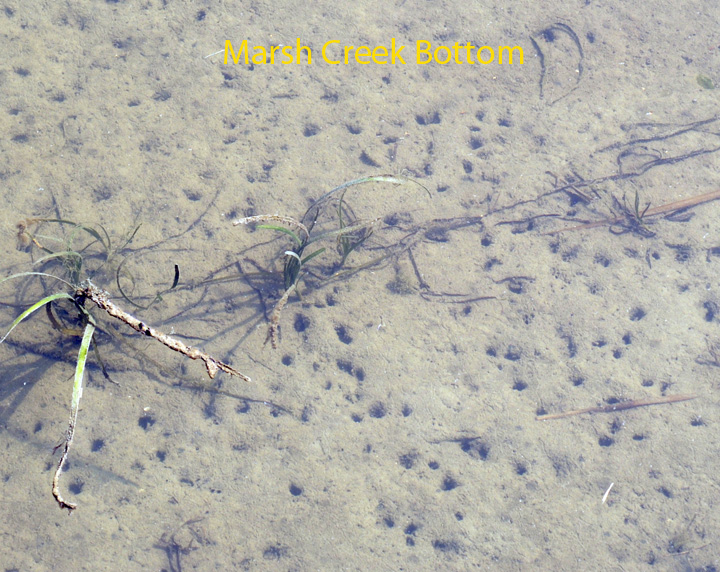
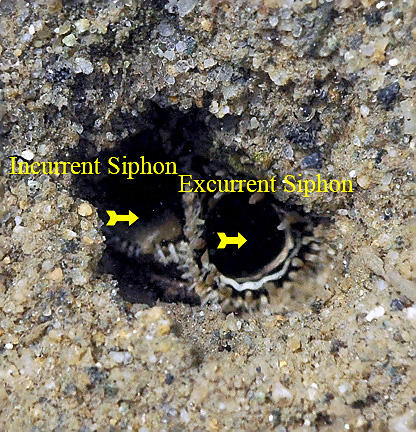
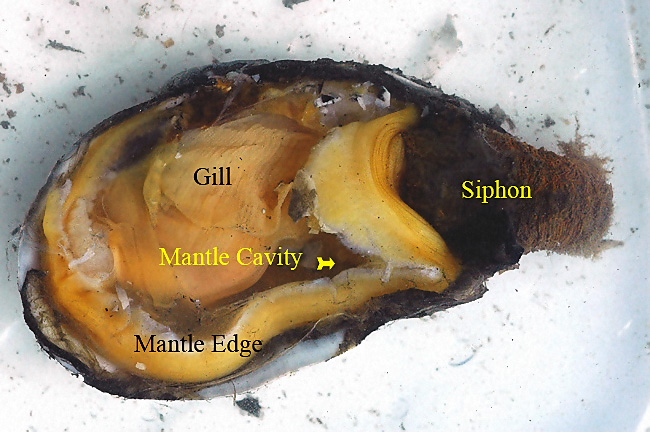
Surface water is drawn in through the incurrent siphon by ciliary action and passed through the gills where food is trapped in mucus produced on the gill surface. Like the great majority of bivalve molluscs they feed by capturing small particles consisting of plankton, organic detritus and bacteria . The mucus and the trapped food are swept to the lower margin of the gills by special tracts of strong cilia and are then brought anteriorly along the food groove at the gill margin to the labial palps which then transfer food to the mouth. This species, about 7 cm long, lives in a burrow beneath the mud surface. In tidal creeks it is associated with mud snails and the common clam worm.
Adaptations:
1. Lives in a burrow that protects them from predators.
2. Has a relatively hard shell that provides extra protection from predators.
3. Has a foot that can pull them quickly downward in the burrow, keeping them out of harms way.
l. Mytilus edulis (Blue Mussel)
http://en.wikipedia.org/wiki/Mytilus_edulis
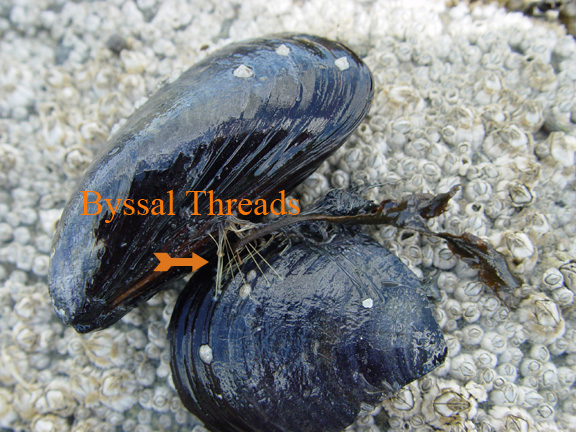
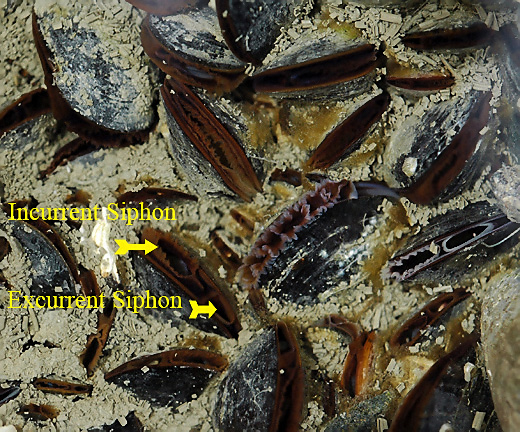
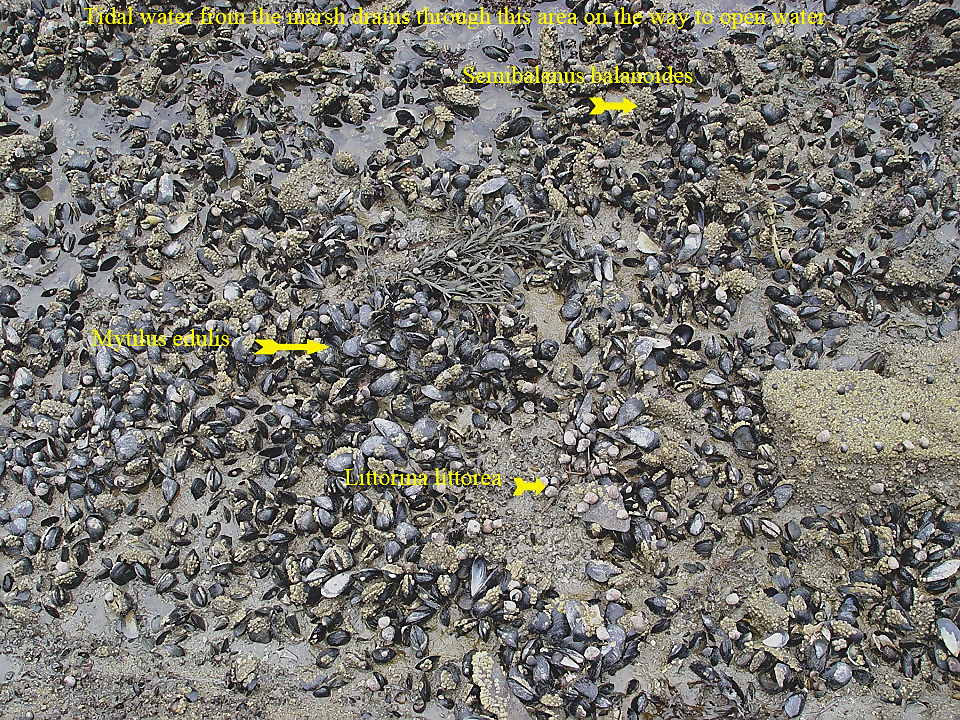
Like the great majority of bivalve molluscs they feed by trapping small particles ,including plankton, organic detritus and bacteria ,in mucus on the gills as the respiratory current passes through them. Mucus and food are swept to the lower margin of the gills by special tracts of strong cilia. Here, mucus mixed with food travels anteriorly along the food groove at the gill margin and is delivered to the palps which transfer food to the mouth. Blue mussels, about 6 cm long, are held in place by strong byssal threads, shown above, secreted by a byssal gland near the base of the foot. The byssal substance consists of a heavily cross-linked, highly viscid, adhesive collagen like protein that undergoes a quinnone-mediated tanning after release from the byssal gland. The gland is applied to the rock, then the protein is secreted and finally the foot is drawn away forming the thread at which point the thread hardens. The feeding mechanism for this species is similar to the soft shell clam and the ribbed mussel.
Adaptations:
1. Has a hard shell that protects them from predators.
2. Secretes tough protein threads that extend from the foot (Byssal Threads) that attach to hard surfaces, holding them firmly in place.
3. Tends to group together with other mussels making it more difficult to dislodge them.
m. Crassostrea virginica (Eastern Oyster
http://en.wikipedia.org/wiki/Crassostrea_virginica
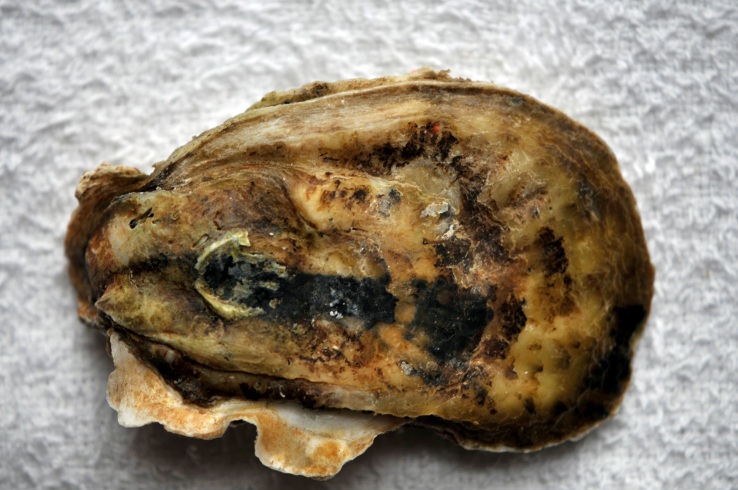
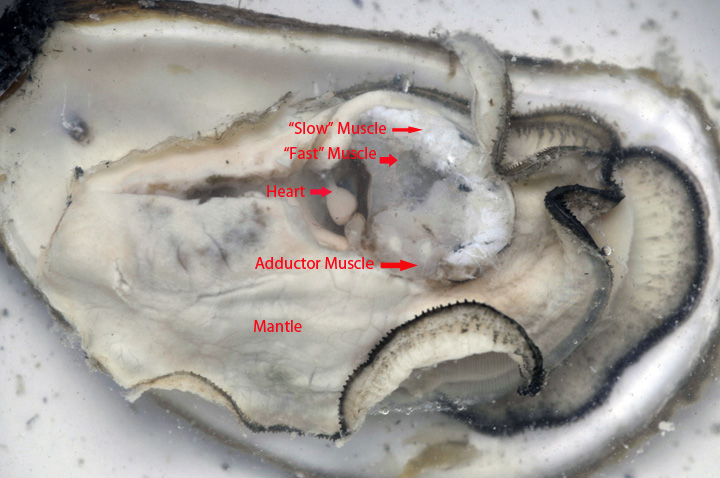
This species has been found at several locations adjacent to salt marshes, in limited numbers.
n. Mercenaria mercenaria (Quahog)
http://en.wikipedia.org/wiki/Mercenaria_mercenaria
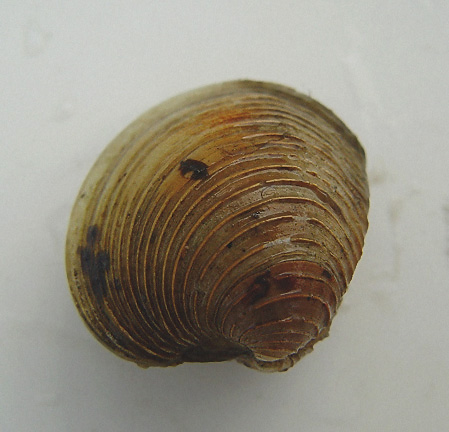
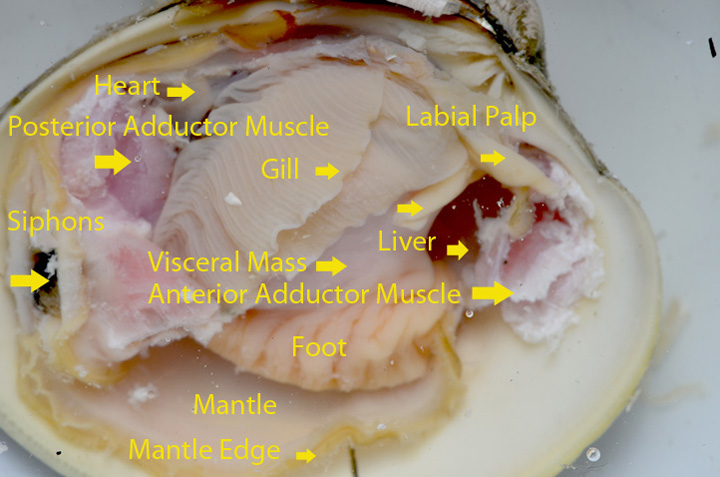
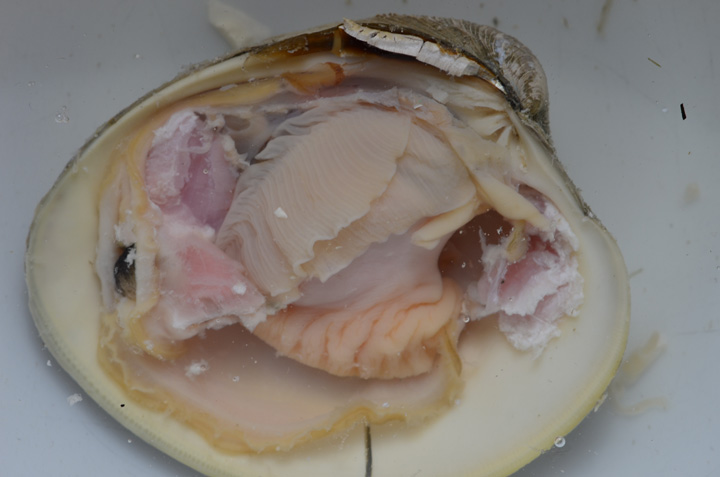
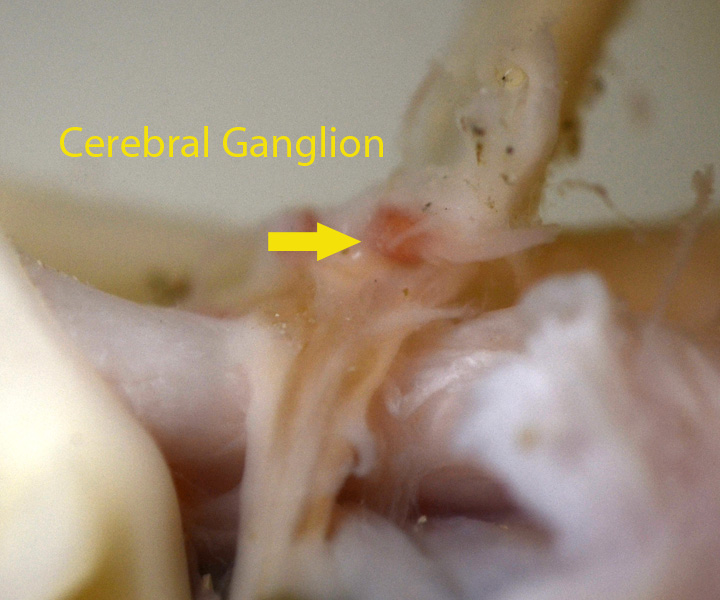
The feeding process and basic anatomy is similar to the soft-shell clam Mya arenaria. The nervous system in all bivalves discussed above is similar also. There is no concentration of nerve tissue at the anterior end. Instead there are three pairs of ganglia (Cerebral, Visceral and Pedal) that are connected. In the quahog, the orange cerebral ganglia are located where the labial palps join; the orange visceral ganglia are attached to the surface of the posterior adductor muscle and the pedal ganglia (Not Photographed) are embedded in the upper part of the foot .
6. Phylum Arthropoda
a. Phylum Arthropoda,Subphylum Chelicerata, Class
Merostomata
Limulus polyphemus (Horseshoe Crab)
http://en.wikipedia.com/wiki/Limulus_polyphemus
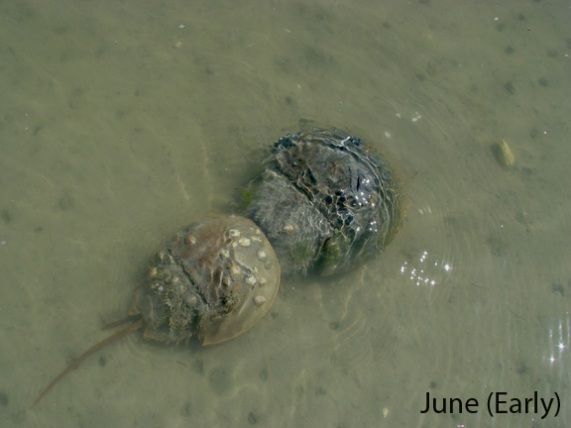
Adults and juveniles live off-shore. Adults move into shallow water during the summer breeding season. Females are about 0.5 meters long while males are much smaller. Males attach to females prior to breeding. After inseminating the eggs, males detach and go their own way. Females dig holes in the sand and deposit the fertilized eggs . The buried embryos develop into juveniles that crawl to the surface and eventually move to deeper water. Juveniles are an important food source for several species of birds.
Adaptations:
1. Hard shell that protects them from predators.
2. A posterior long extension (Caudal Spine or Telson) that helps the animal right itself if turned upside down.
b. Phylum Arthropoda (Class Malacostraca, Order
Amphipoda)Gammarus sp. (about 10 mm long) (Side
swimmers or Scuds)
http://en.wikipedia.org/wiki/Gammarus
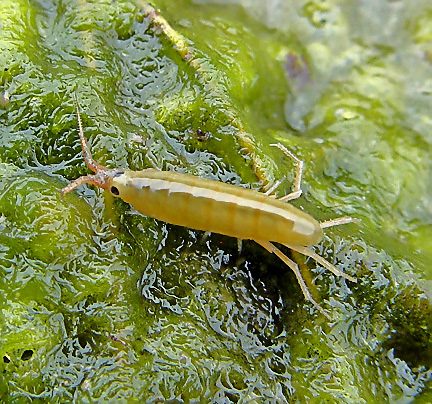
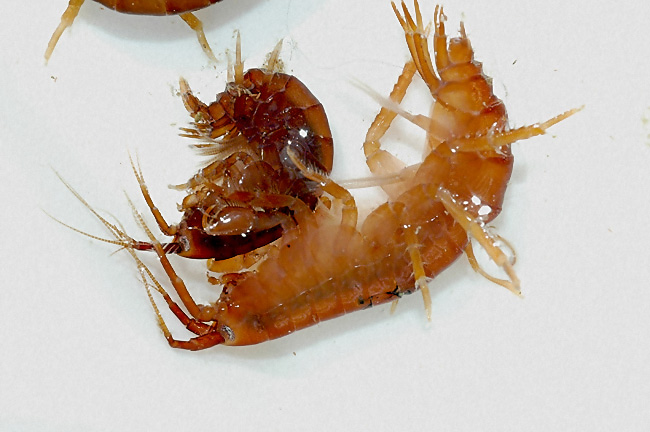
Gammarus is a genus of amphipods common to both marine and freshwater environments. Although they are scavengers they feed for the most part on algae, eelgrass (Zostera) and cord grass (Spartina) detritus. After food has been digested, what remains is passed out of the digestive tracts as fecal matter and becomes food for other organisms. They can walk on the sediment surface or swim rapidly on their sides. The reddish mating amphipods are not found in the marsh, however they are shown here to illustrate external amphipod anatomy (Refer to the amphipod video in the Marsh Pool section for a discussion of external amphipod anatomy).
Adaptations:
1. Ability to swim or walk on solid surfaces.
2. Exoskeleton that helps protect the animal from physical injury.
c. Phylum Arthropoda (Class Malacostraca,Order
Decapoda)
Cancer irroratus (Rock Crab)
http://en.wikipedia.org/wiki/Cancer_irroratus
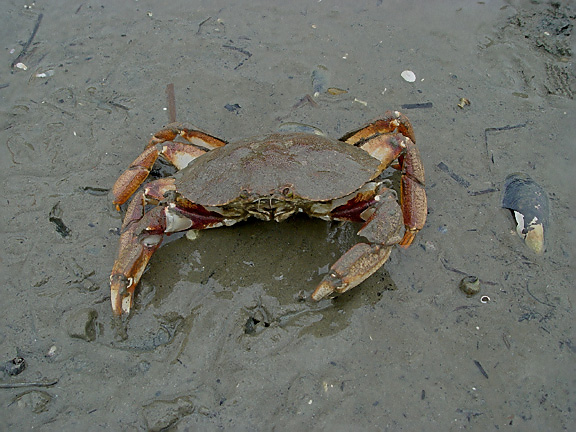
The Rock Crab , about 9 cm wide, , is often found on mud flats just below the marsh proper. It feeds on polychaete worms, snails and bivalve molluscs as well as other invertebrates.
Adaptations:
1. Hard exoskeleton that protects them from predation.
2. Ability to dig down into mud/sand, thus avoiding detection by predators.
3. Strong crusher claw that allows them to crack open the shells of snails and bivalves.
Carcinus maenas (Green Crab)
http://en.wikipedia.com/wiki/Carcinus_maenas
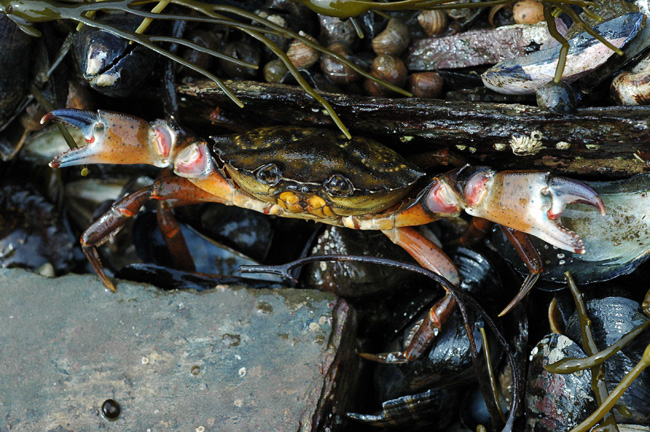
This species, about 8 cm wide, is a European native (North Sea and Baltic Sea shorelines). It is a voracious predator feeding on bivalve molluscs, snails, other crabs, and a number of other organisms.
Adaptations:
1. Hard exoskeleton that protects them from physical injury.
2. Cryptic coloration that allows them to blend into the background.
3. Crusher claw that allows them to feed on bivalves and snails.
4. Shredder claw that allows them to tear food quickly into edible pieces.
Crangon septemspinosus ( Sand Shrimp)
http://en.wikipedia.org/wiki/shrimp
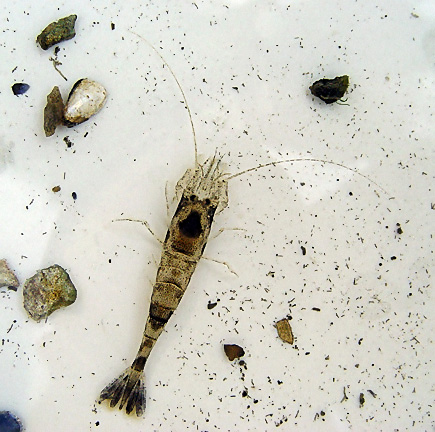
The sand shrimp moves onto the marsh as the tide rises. It feeds on detritus as well as pieces of marsh and eel grass. The grasses are chewed into smaller pieces some of which are consumed. The portion ingested is converted to shrimp biomass and fecal pellets that are available to other deposit feeding invertebrates. Grass pieces not consumed fall to the bottom and are colonized by more bacteria making them an attractive food source for other species.
Adaptations:
1. Specialized posterior appendages (Telson) that allow quick backward movement.
2. Ability to adjust body color (Chromatophores) to the background.
Mysid Shrimp (Mysidaceae)
http://en.wikipedia.org/wiki/Shrimp
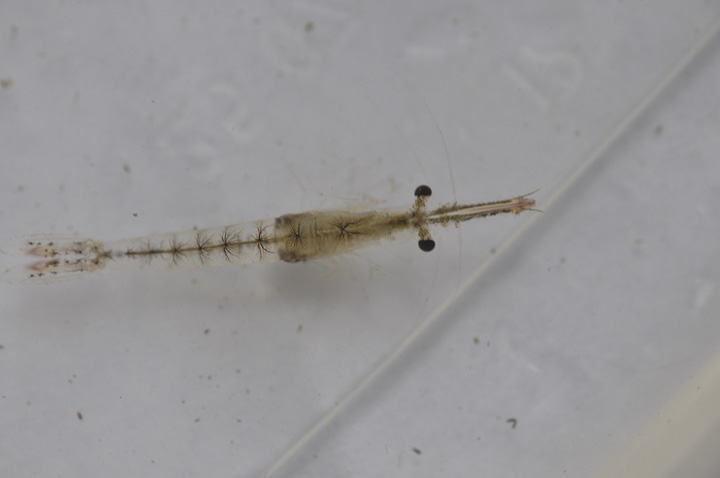
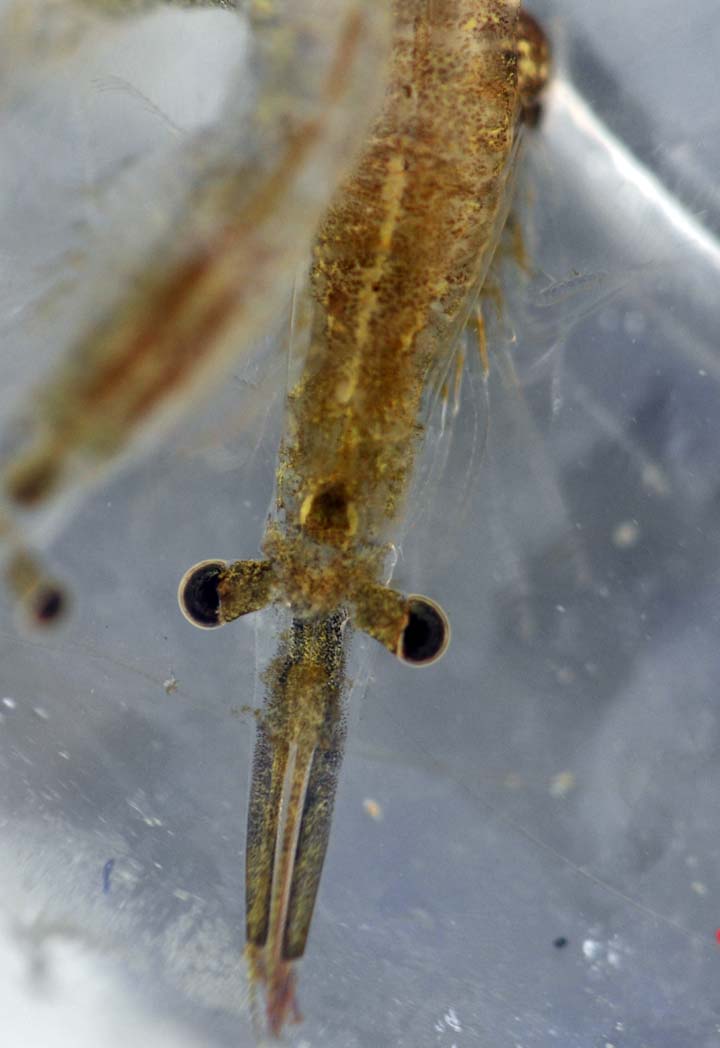
Mysids , about 25 mm long, are sometimes called opossum shrimp because of the ventral marsupium where young are brooded. This species, present in large numbers, is an omnivore feeding for the most part on decayed vegetation and dead organic matter. Note the relatively long characteristic eye stalks.
Pagurus longicarpus (Long-armed Hermit Crab)
http://en.wikipedia.org/wiki/Pagurus_longicarpus
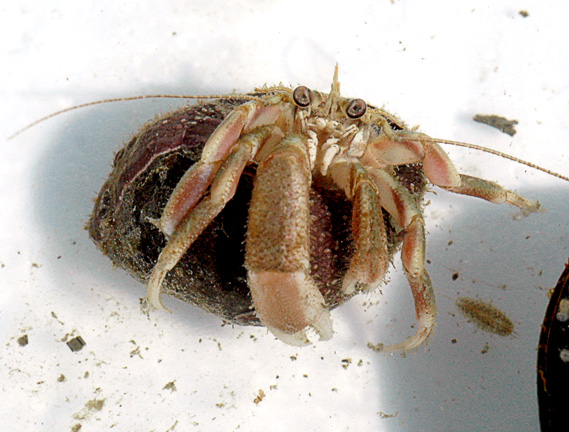
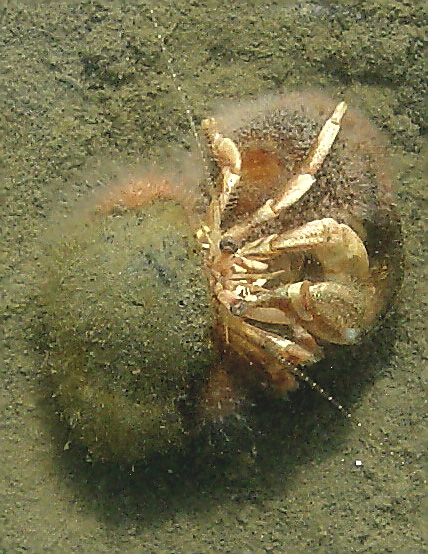
This species, about 2 cm long, feeds for the most part on animal and plant detritus, on living diatoms associated with detritus, and larger pieces of dead or dying invertebrates. The specimens above were found at the water outflow from a small marsh. Note the pink hydroid, Hydractinia spp., attached to the shell of the periwinkle Littorina littorea.
Adaptations:
1. Occupies empty snail shells providing protection from predators.
2. Ability to retract almost completely into the occupied shell, exposing only the tips of the claws.
d. Phylum Arthropoda (Class Malacostraca ,Order
Isopoda)
Isopod
http://en.wikipedia.org/wiki/Isopod
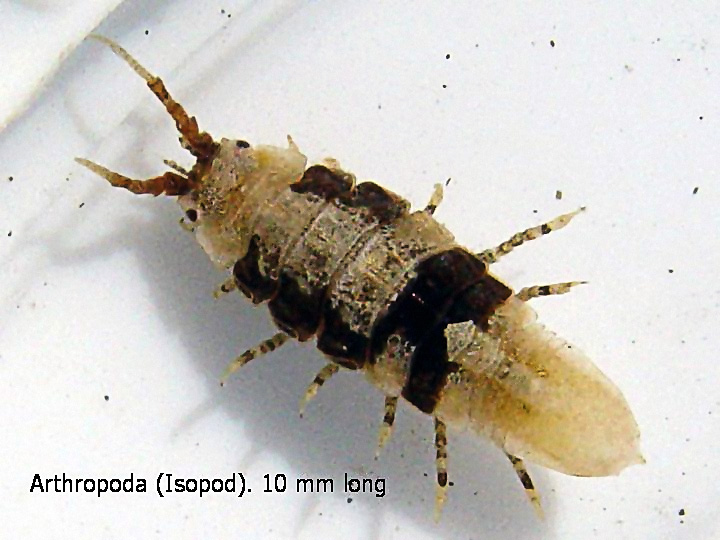
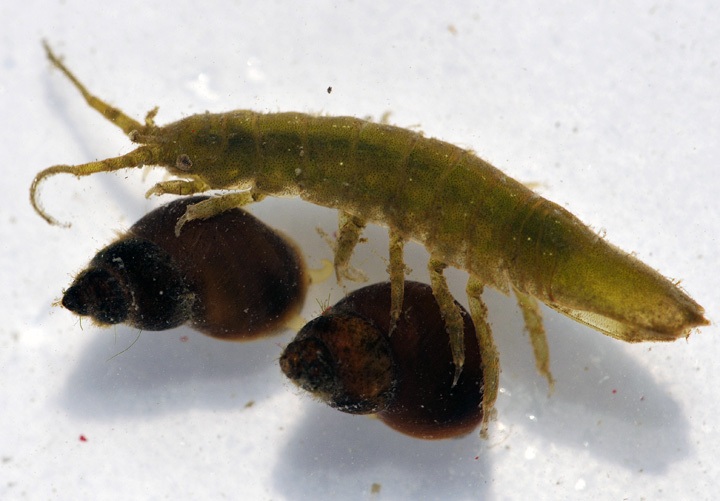
The isopod body is flattened dorso-ventrally. This feature distinguishes isopods from amphipods that are compressed laterally. Most isopods are scavengers feeding for the most part on algae, eelgrass, and cord grass detritus.
Adaptations:
1. Cryptic coloration that helps them blend into the background.
2. Exoskeleton that protects them from physical injury.
e. Phylum Arthropoda (Class Cirripedia)
Semibalanus balanoides (Common Rock Barnacle)
http://en.wikipedia.org/wiki/Semibalanus_balanoides
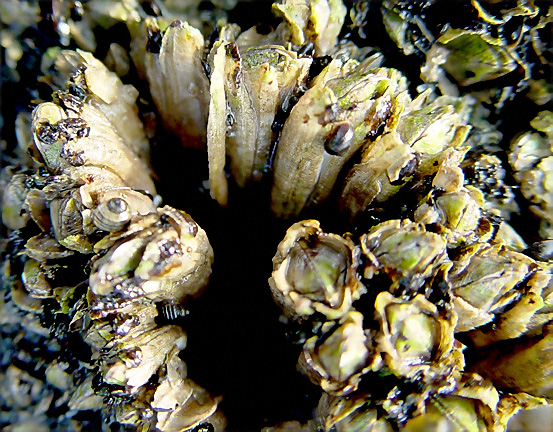
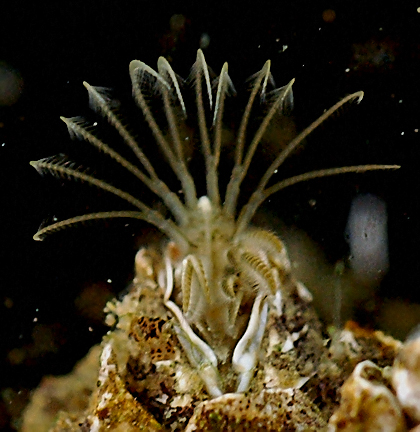
Semibalanus balanoides, about 1 cm wide, is enclosed in a calcareous shell. The volcano shaped shell consists of a basal part cemented to hard surfaces, six non-moveable side plates and one or two pairs of moveable plates at the top that allow the barnacle to seal itself from the outside environment during periods of stress or alarm. The moveable plates can be separated to allow protrusion of the thoracic limbs, the cirri, during feeding. The cirri , when they are extended from the shell, form a net, as shown above, that scoops the water immediately above the opening of its shell. When retracted the cirri come together, enclosing any food particles and upon further retraction the food is brought into the mantle cavity where it is scraped off the cirri and transferred to the mouth by appendages called maxillae. The cirri have small lateral extensions (visible) that help trap food particles. Barnacles attach to hard surfaces either in the marsh proper or in the area where tidal water drains from the marsh.
Adaptations:
1. The barnacle lives inside a shell that is glued to the substratum.
2. The animal can completely withdraw into its shell for long periods of time, protecting them from predators and environmental extremes.
3. The feeding appendages (Cirri), shown above, are well adapted (Note the small lateral extensions on the cirri) for trapping small particles in the water column.
f. Phylum Arthropoda (Class Insecta, Family Corixidae)
Water Boatman
http://en.wikipedia.org/wiki/Corixidae
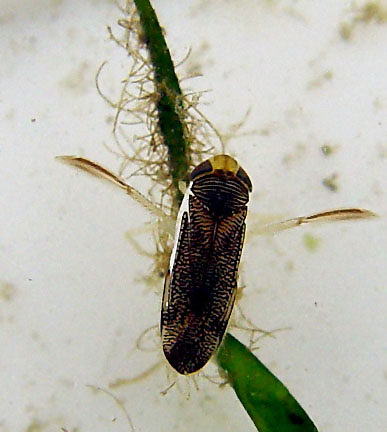
g. Phylum Arthropoda (Class Insecta, Family Gerridae)
Water Strider
http://en.wikipedia.org/wiki/Gerridae
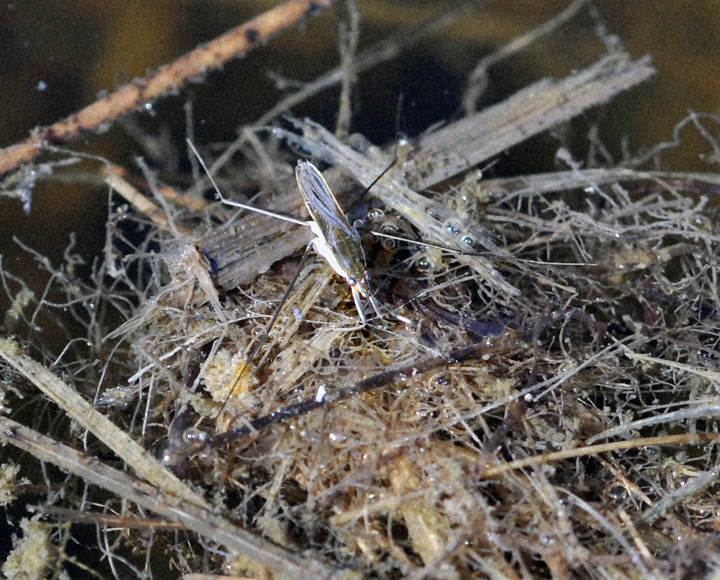
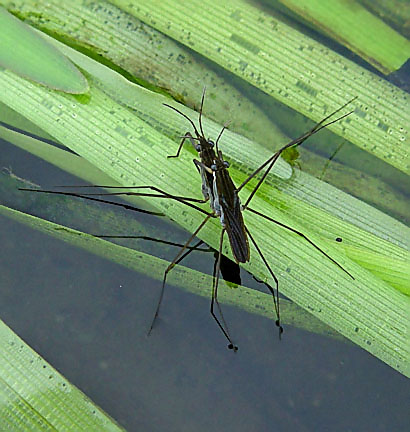
7. Phylum Hemichordata (Class Enteropneusta)
Saccoglossus kowaleski (Acorn Worm)
http://en.wikipedia.org/wiki/Saccoglossus_kowaleski
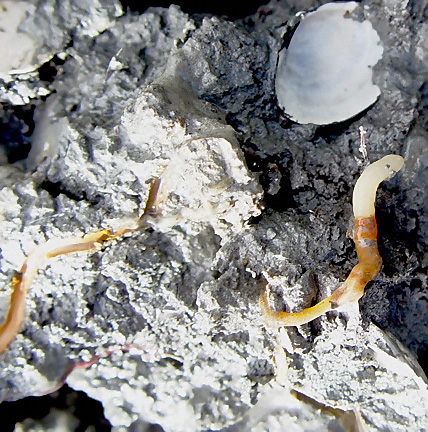
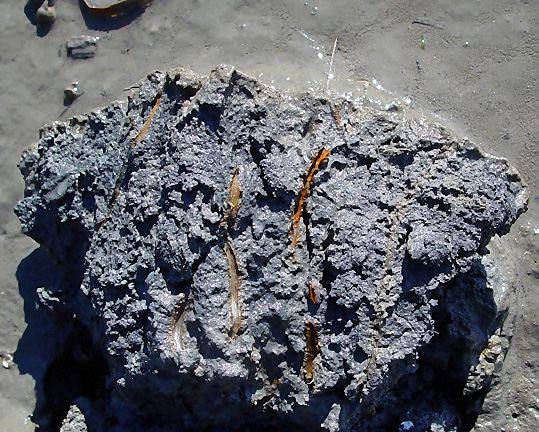
The acorn worm body, about 10 cm long, is divided into three parts (proboscis, collar and trunk). The proboscis, shown above, is white, followed by an orange collar attached to a pale orange trunk. The mouth (not visible) is located in front of the collar. Gill slits, not seen here, can be found on the anterior portion of the trunk. Oxygenated water, directed into the mouth by cilliary action, leaves through the gill slits. During feeding, the white proboscis is extended from the anterior end of its U-shaped burrow and placed on the mud surface. Mucus secreted by the proboscis adheres to the mud and the mucus/food is directed by cilliary action into the mouth. Micro algae and diatoms in the sediment are their main source of food. Fecal matter is deposited in strings at the opposite end of the burrow as shown above. Filter feeding has also been reported.
Adaptations:
1. An underground burrow that provides protection against predators.
8. Phylum Chordata (Sub-Phylum Urochordata)
Molgula spp., Sea Squirt
htpp://en.wikipedia.org/wiki/Molgula
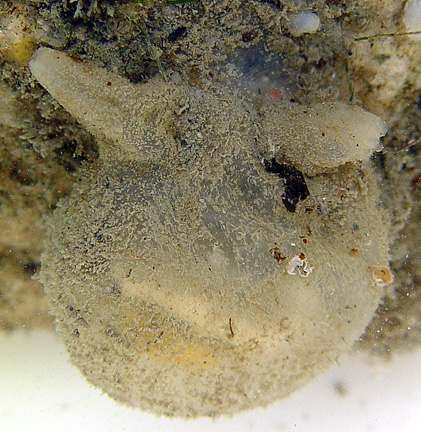
Botryllus schlosseri, Goldenstar Tunicate
http://en.wikipedia.org/wiki/Botryllus_schlosseri
Algae
1. Green Algae (Chlorophyta)
a. Chaetomorpha spp.
http://en.wikipedia.org/wiki/Chaetomorpha

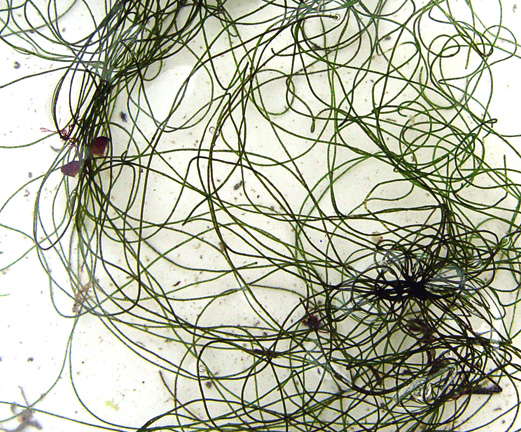
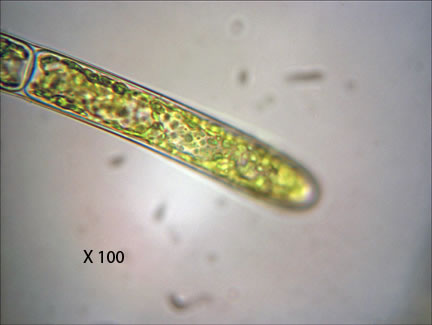
Chaetomorpha is composed of an unbranched chain of cells. It is sometimes called Mermaids Hair. Chaetomorpha is a preferred food of certain amphipods and isopods and serves as a substrate for attachment by other organisms. Chaetomorpha spp. is an important source of food for organisms in marine aquaria and several marine species are dried, ground up, and used to flavor food.
Adaptations:
1. A basal holdfast that secures the algal filament to a solid surface.
2. A fast growth rate
b. Cladophora spp.
http://en.wikipedia.org/wiki/Cladophora
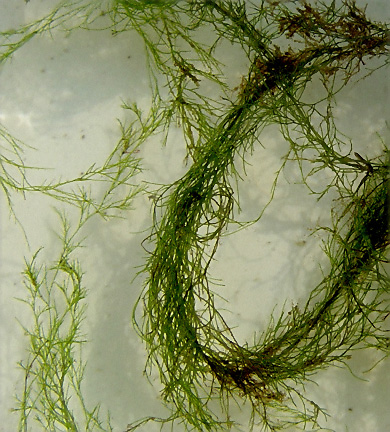
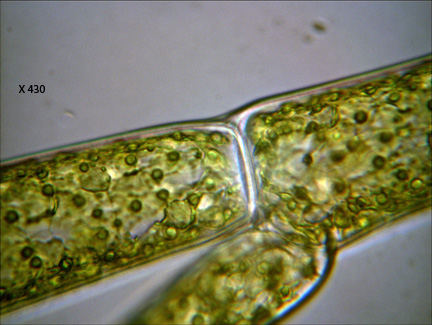
Cladophora, composed of a branched chain of cells, is a preferred food of certain amphipods and isopods. It also serves as a substrate for the attachment of microorganisms.
Adaptations:
1. A basal holdfast that secures the filament to a solid substratum.
2. A branched filament that provides increased surface area which provides greater exposure to light.
c. Enteromorpha spp.
Http://en.wikipedia.org/wiki/Enteromorpha
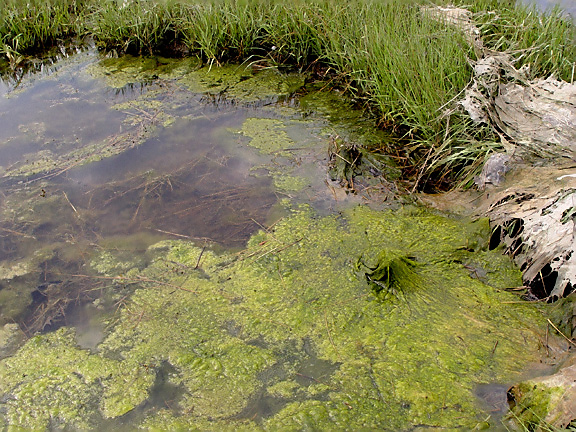
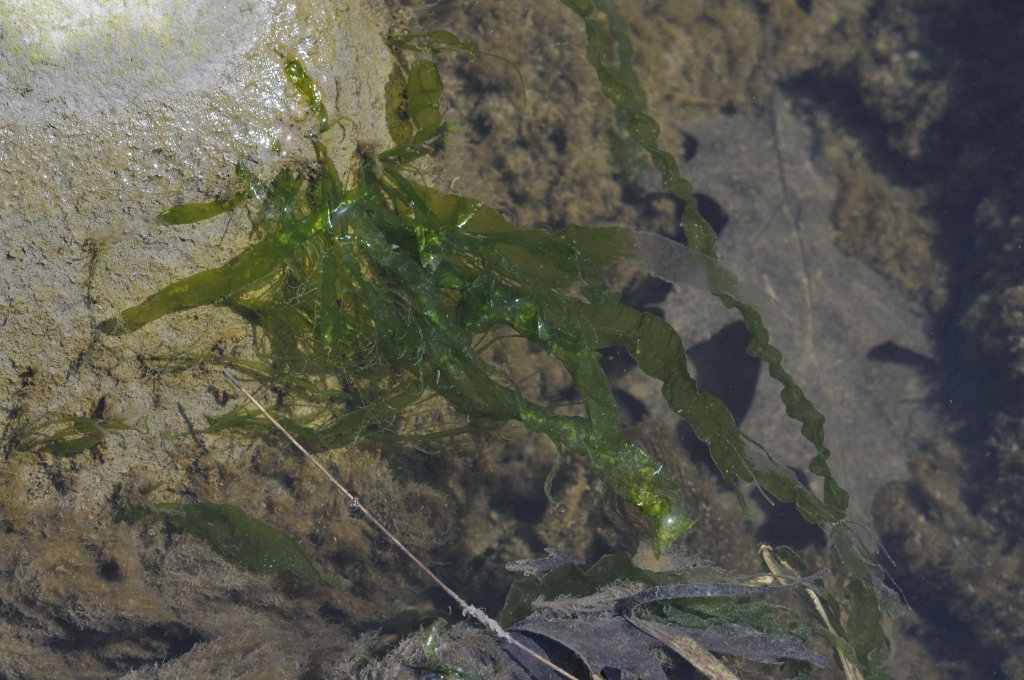
The tubular green alga is attached to the bottom by a holdfast. It is an important food source for amphipods and isopods as well as snails such as the periwinkle. Enteromorpha intestinalis, a common marine species, called green nori, is dried, powdered, and used to flavor foods.
Adaptations:
1. A basal holdfast that secures the filament to a solid substratum.
2. A branching thallus that provides increased surface area which provides greater exposure to light.
d. Ulva lactuca (Sea Lettuce)
http://.en.wikipedia.org/wiki/Ulva_lactuca
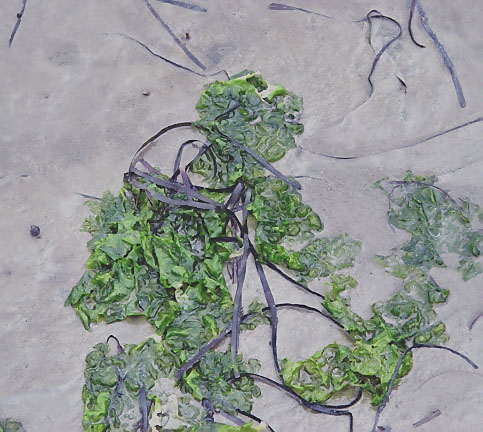
Ulva, about 8 cm long, consists of a sheet of cells ,two cells thick. It is firmly attached to the substratum by a basal holdfast. Ulva has two morphologically similar forms, sporophyte and gametophyte. Cells along the edge of the sporophyte undergo reduction division to produce haploid spores with 4 flagella. Each spore grows into a haploid gametophyte. Cells on the edge of the gametophyte form bi-flagellate gametes by cell division. Gametes in the water column join to form a diploid zygote that will grow into a sporophyte. It is used as a flavoring in salads and soups.
Adaptations:
1. A holdfast that provides solid attachment to the bottom.
2. Production of large numbers of asexually formed haploid spores that increase it’s reproductive potential.
3. Production of large numbers of sexually formed diploid sex cells that also increase it’s chances of survival.
2. Red Algae (Rhodophyta
Chondrus crispus (Irish Moss)
www.en.wikipedia.org/wiki/rhodophyta
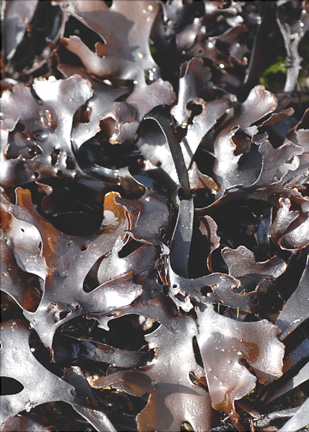
The red alga Chondrus crispus (Irish Moss) forms a dense turf that adheres closely to solid surfaces. Attachment is achieved by means of a basally situated disk-shaped holdfast that is glued to the rock surface. The close cropped algal turf tends to retain water providing a suitable environment for many invertebrates such as amphipods and isopods. Carrageenan, a sulfated polysaccharide, is extracted from Chondrus crispus (Irish Moss) and several other species of red algae. It is used in hand lotions, chocolate milk, toothpaste, ice-cream, etc., as a stabilizing and gelling agent.
Adaptations:
1. A disc-shaped holdfast that provides strong attachment to the substratum
2. A thick thallus that resists abrasion.
Dumontia spp.
Http://en.wikipedia.org/wiki/Dumontia
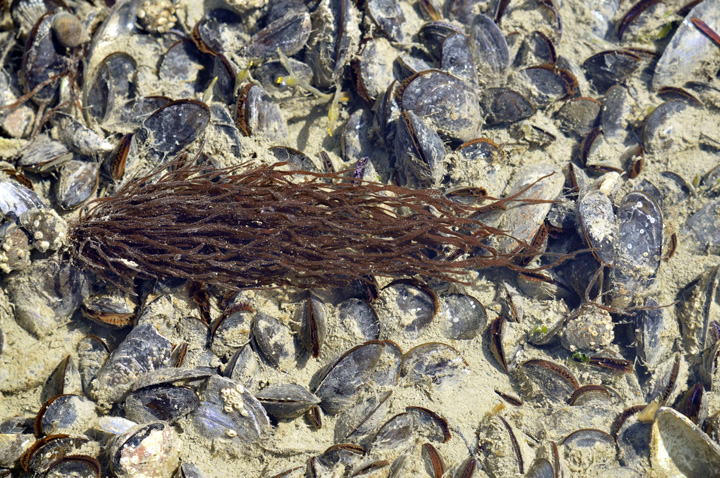
3. Brown Algae (Phaeophyta)
a. Ascophyllum nodosum . Refer to the description in the Spartina alterniflora Zone section.
Http://en.wikipedia.org/wiki/Ascophyllum_nodosum
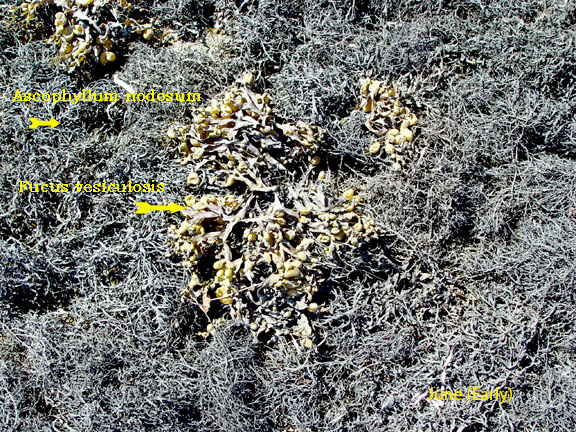
b. Fucus vesiculosis. Refer to the description in the Spartina alterniflora Zone section.
Http://en.wikipedia.org/wiki/Fucus_vesiculosis
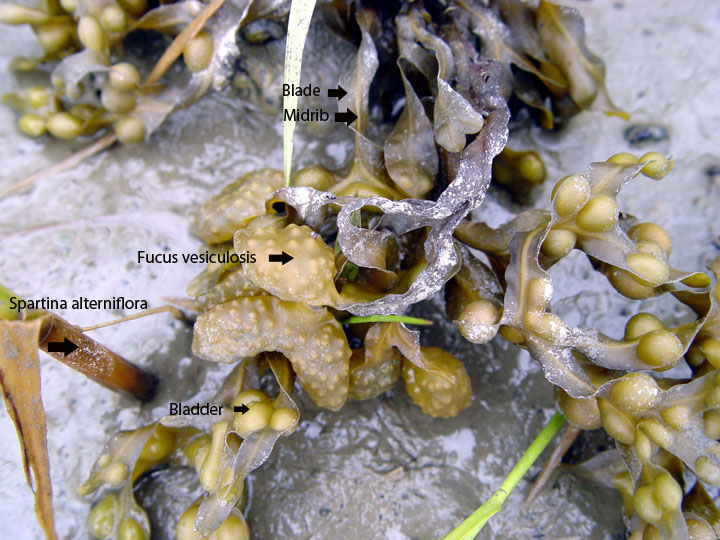
c. Petalonia spp. Note the small holdfast and brown blade.
Http://en.wikipedia.org/wiki/Petalonia
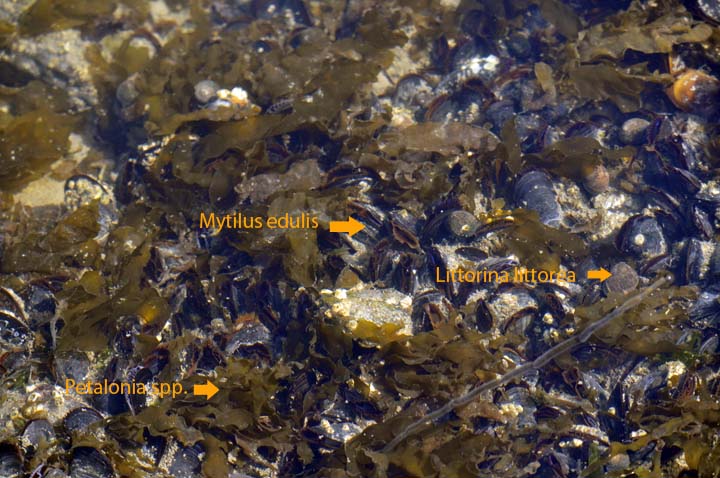
d. Scytosiphon spp. Note the characteristic constrictions along the tubular thallus
Http://en.wikipedia.org/wiki/Scytosiphon
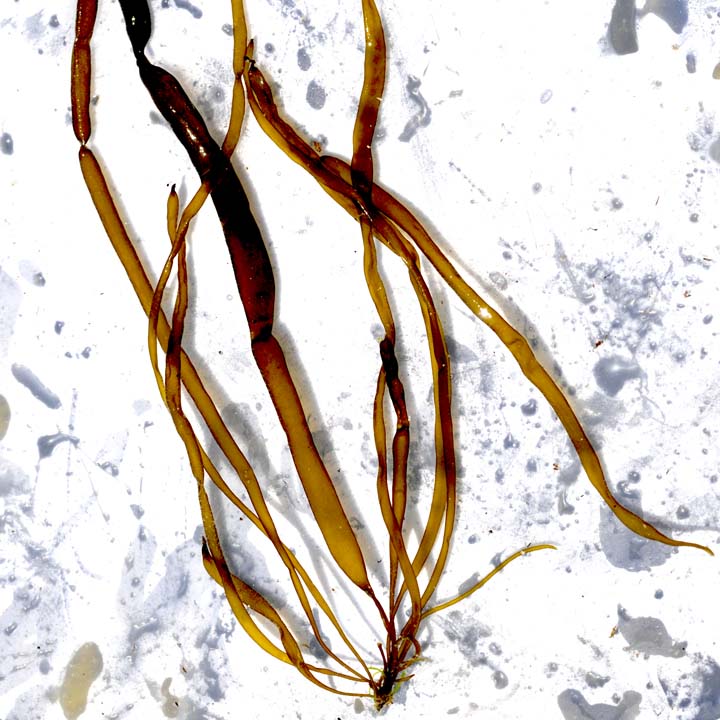
Higher Plants
Zostera marina, Eelgrass (Zosteraceae (Eelgrass Family)
http://en.wikipedia.org/wiki/Eelgrass
http://plants.usda.gov/java/profile?symbol=ZOMA
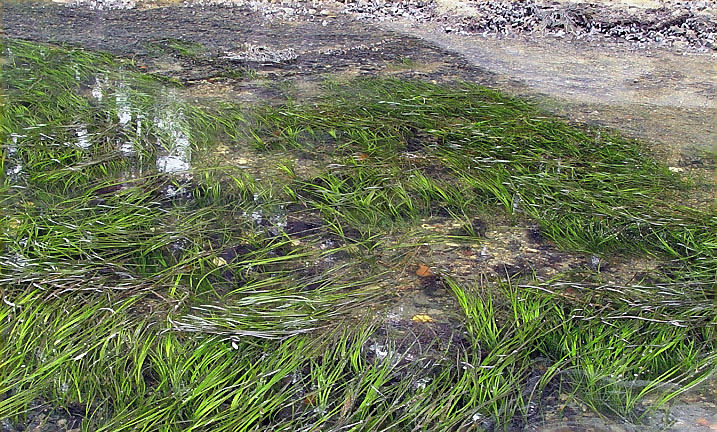
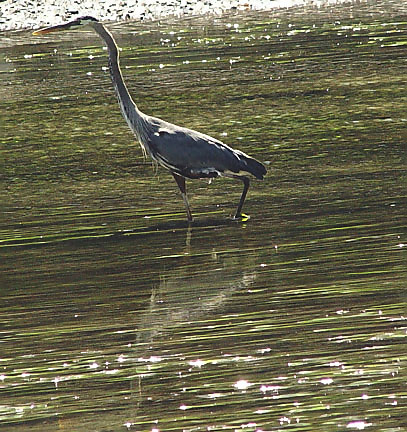
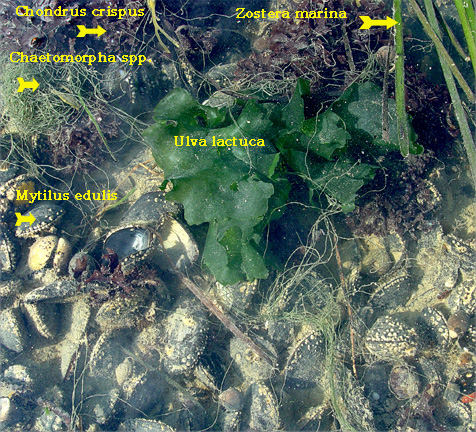
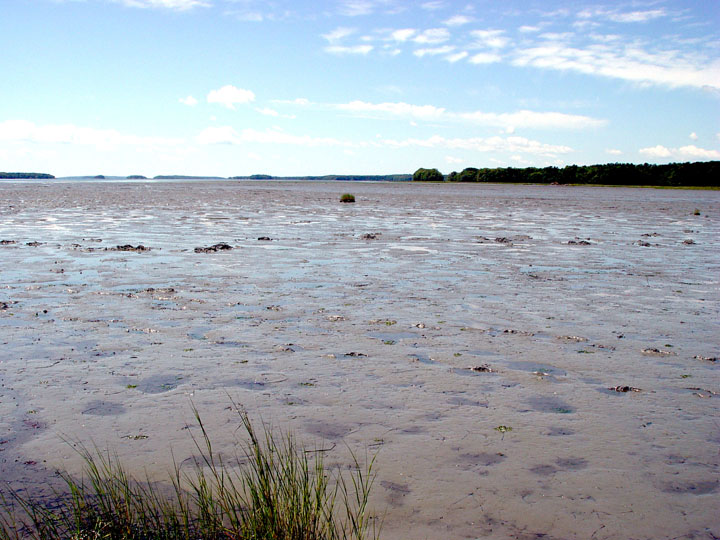
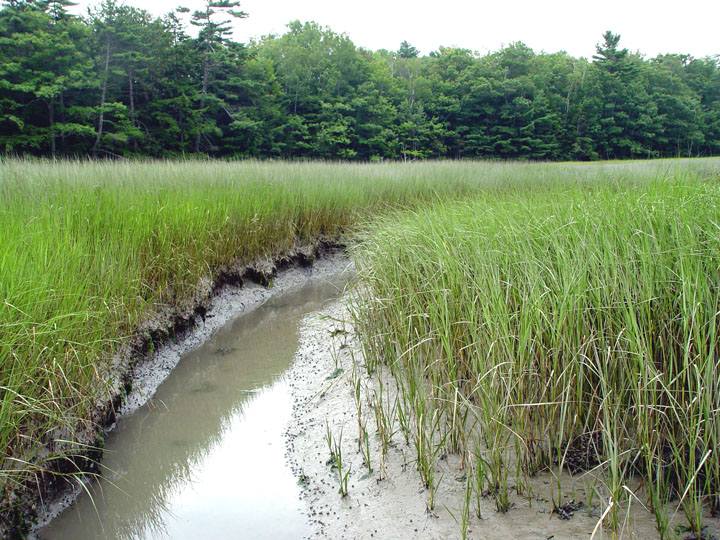
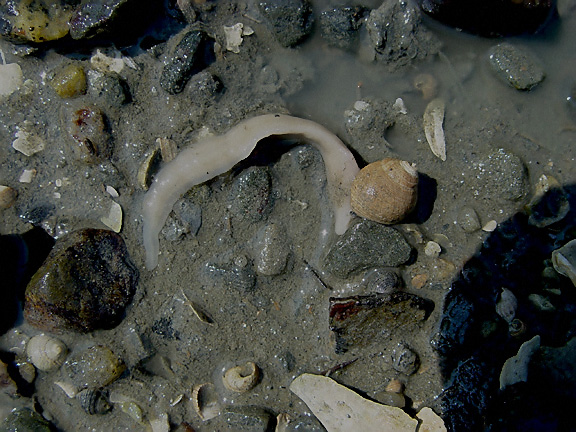
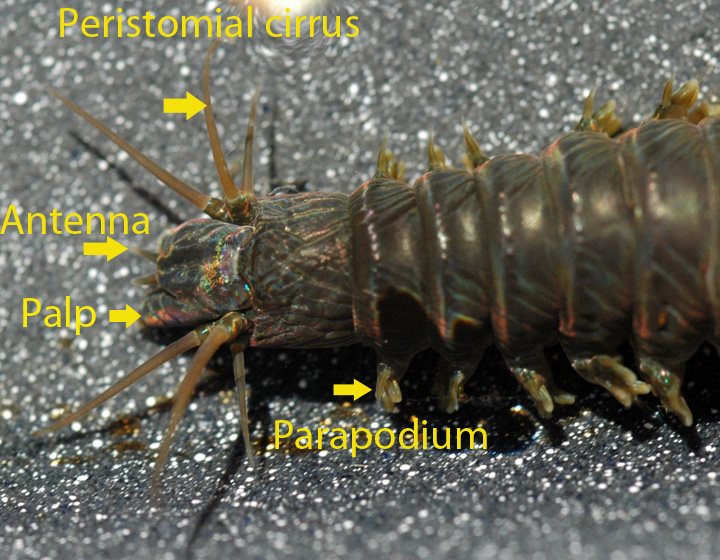
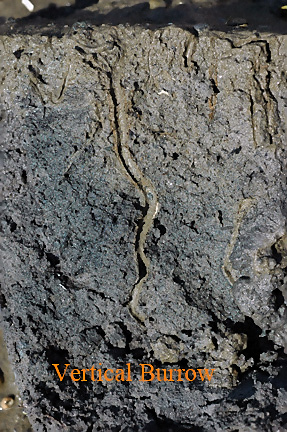
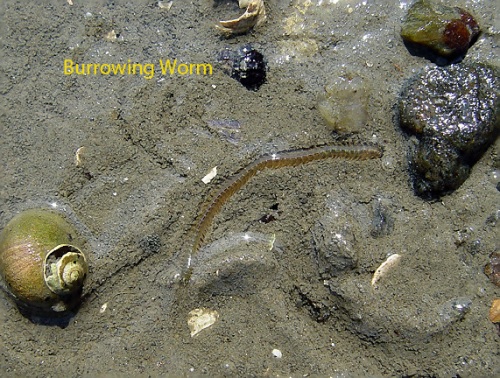
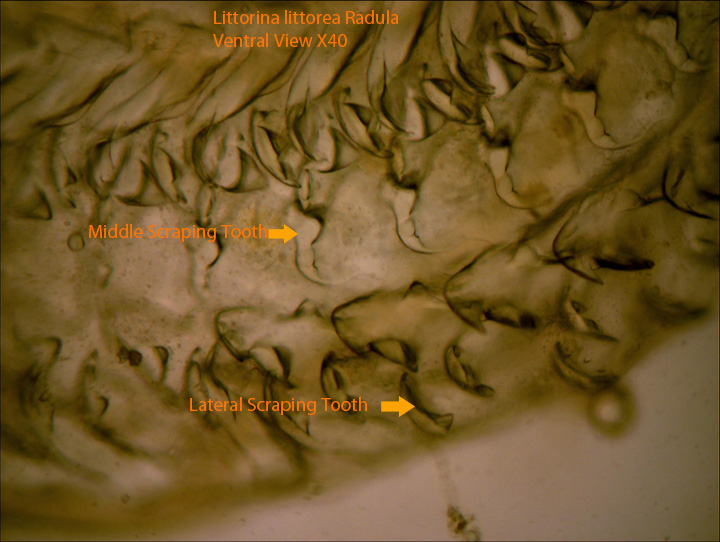
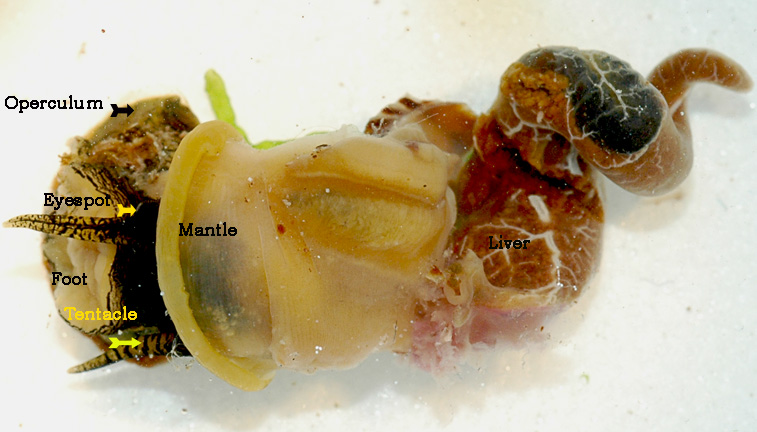
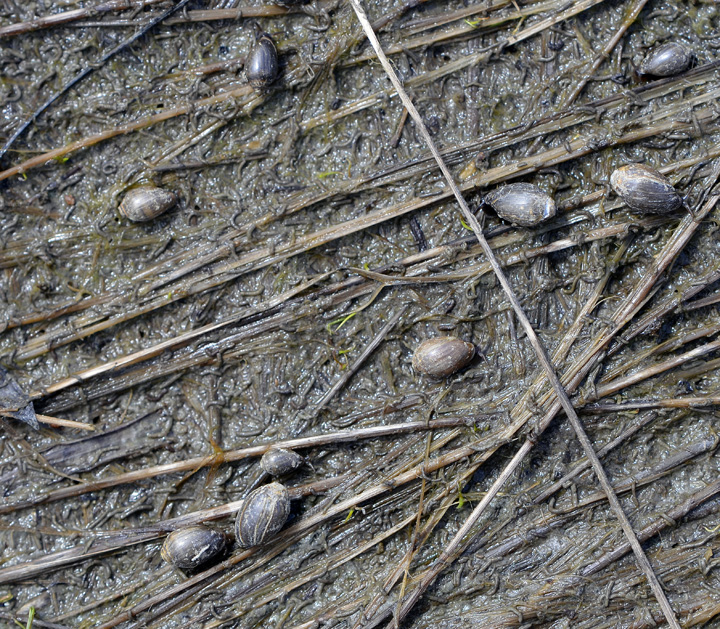
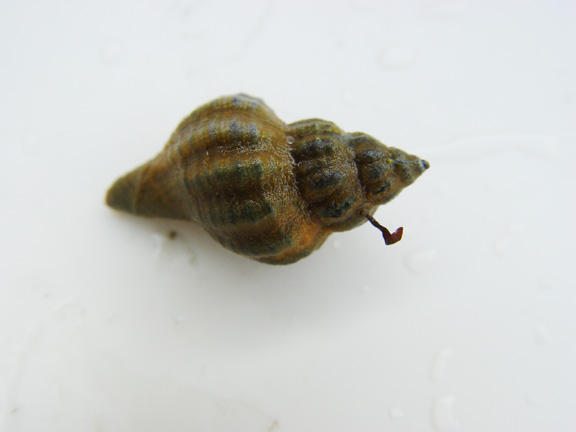
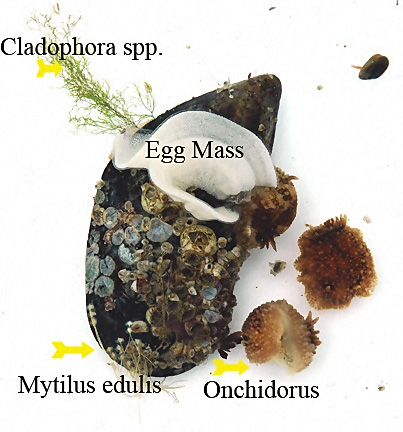
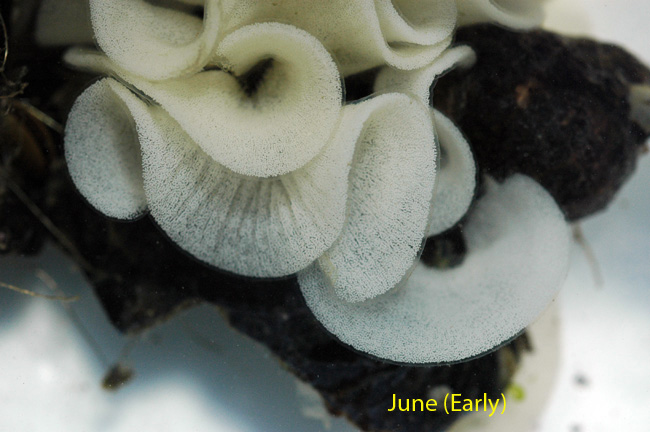
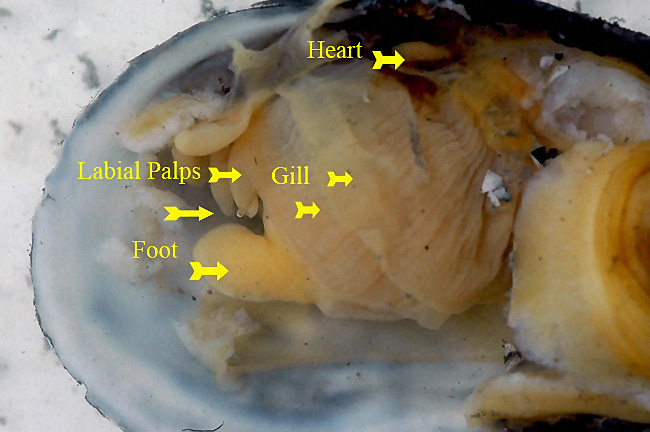
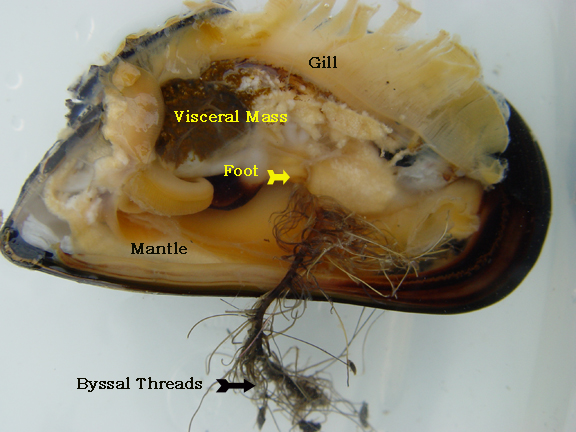
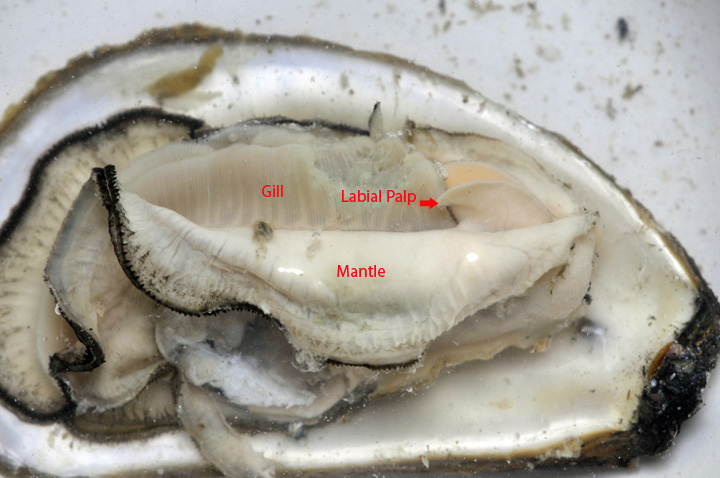


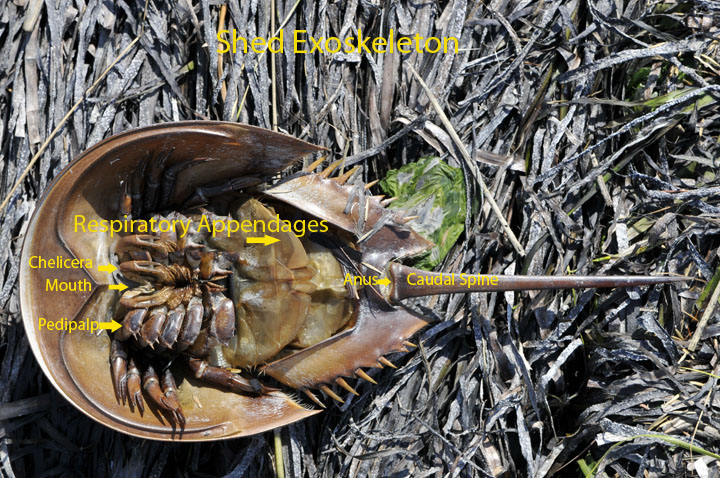
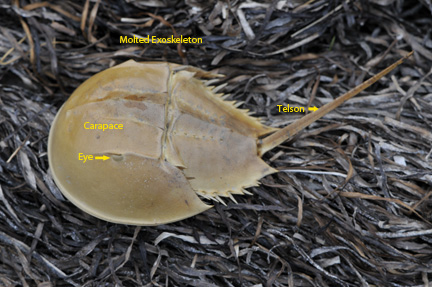
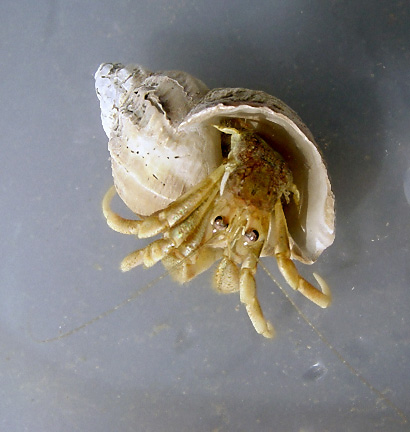
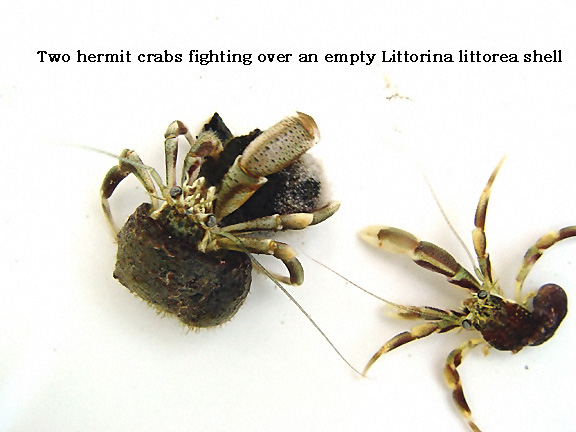
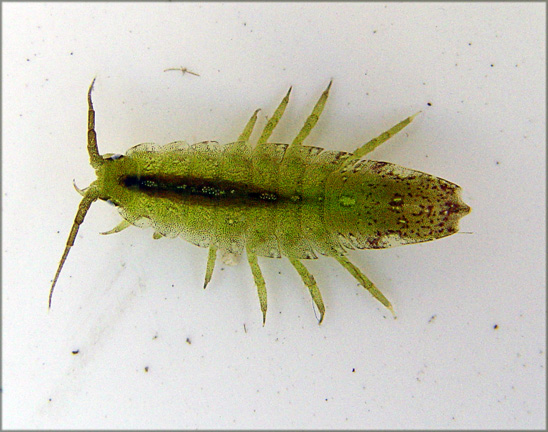
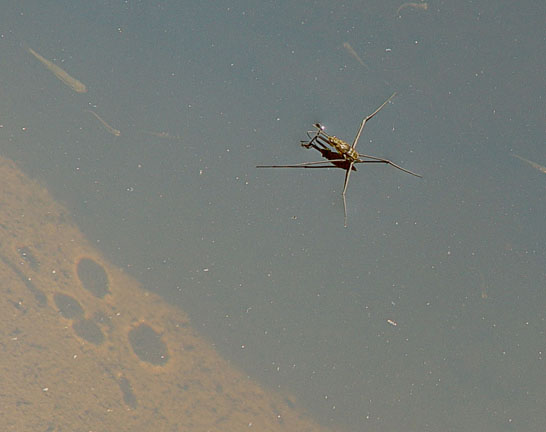
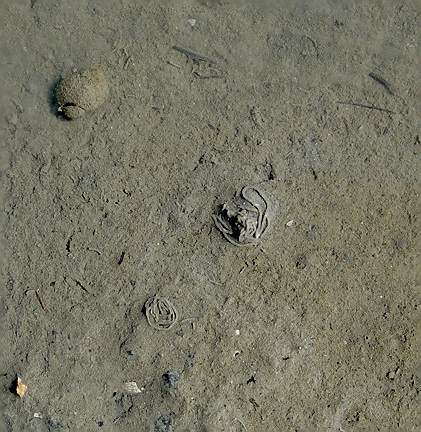
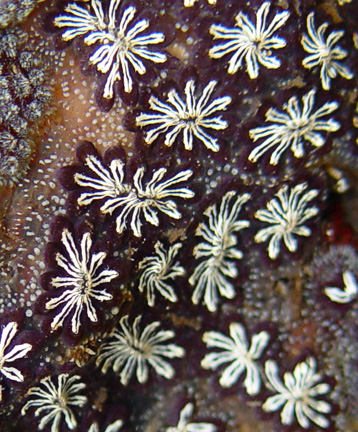
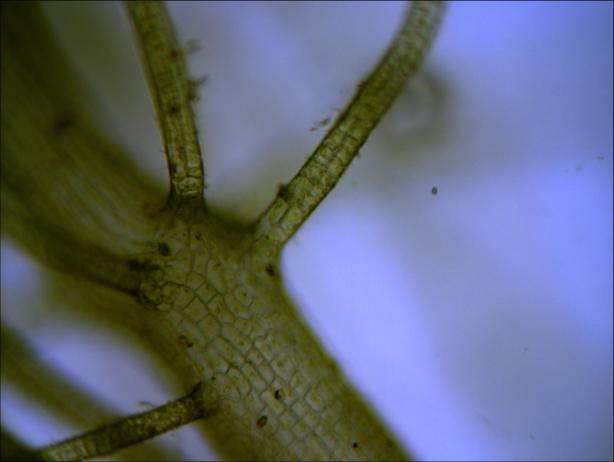
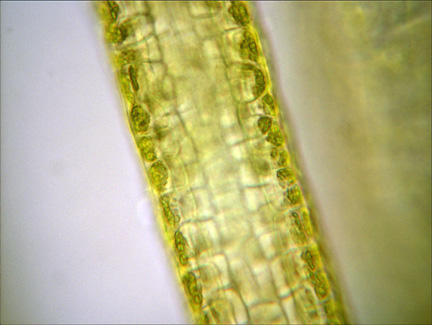
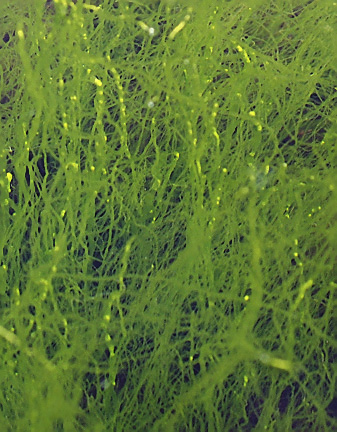
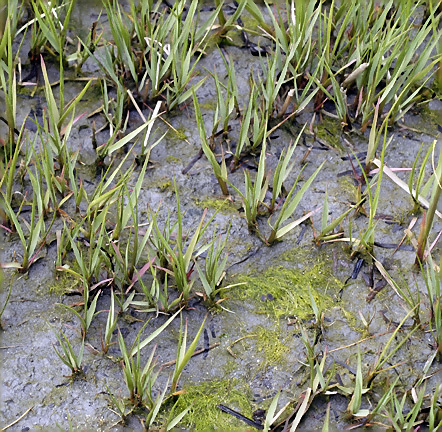
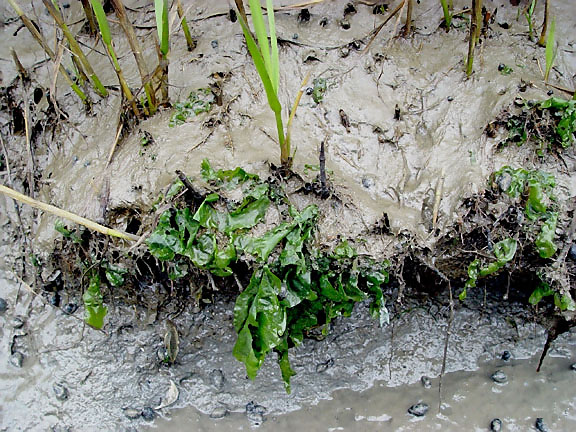
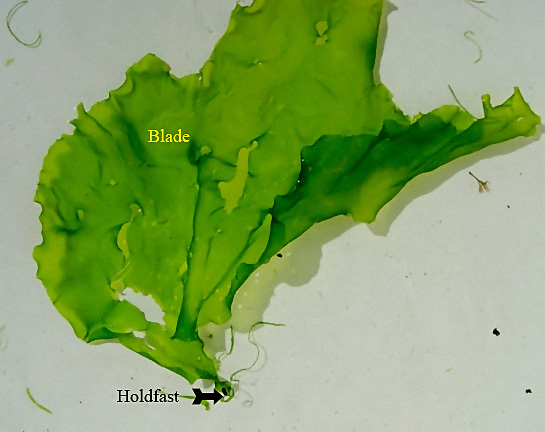
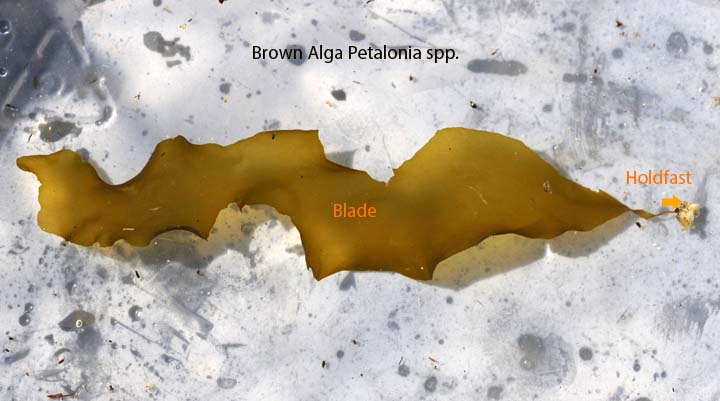
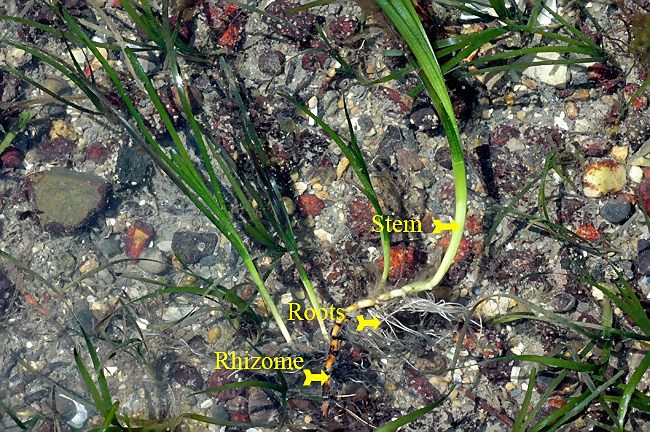
These photos are awesome! Any chance you would allow use of these at the Maine State Aquarium (state government, non-profit) in Boothbay? We are updating our informational panels/tablets and are in the hunt for good photos of some of our local species. We would definitely put your attribution on them and not distribute them. Thank you for your consideration!